Please Report Any Broken Links Or Trouble You Might Come Across To The Webmaster.
Please Take A Moment To Let Us Know So That We Can Correct Any Problems And Make Your Visit As Enjoyable And As Informative As Possible.
| Click On Image For Full Size |
Size | Image Description | Source | |
|---|---|---|---|---|
| July 1937 - July 1942 / Construction - Shakedown |
||||
 |
41k | Sketch designs for the South Dakota (BB-57), as presented to the General Board in August 1937. The insert shows the division, as opposed to fleet, flagship version. At this stage the fleet flagship had a two-level conning tower, flag facilities being accomadated in the after half of the navigational level. Note the centerline 5-inch guns. | Photo and text courtesy of U.S. Battleships: An Illustrated Design History by Norman Friedman. | |
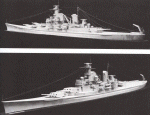 | 70k | The Iowa class (BB-61 / 66) preliminary design model shows the kinship between this class and the South Dakotas. Note the hull slot, which was fared over when the ships were built. The model also shows the usual prewar compliment of 12-foot navigational range finders (including one atop No.3 turret) and range clocks (the forward one is just visible under the platform atop the forward fire control tower). Note, too, the usual pair of boat cranes. They were never fitted, and the planned boat stowage was replaced by three quadruple 40mm mounts on each side, on high platforms. When the New Jersey (BB-62) was being refitted in 1982, workmen found the original boat skids under these platforms. The object atop the conning towers is a spotting glass, which actually was installed aboard the South Dakotas but not aboard these ships. | Photo and text courtesy of U.S. Battleships: An Illustrated Design History by Norman Friedman. | |
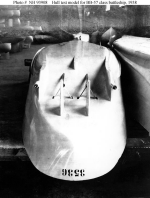 |
76k | Hull test model for the South Dakota class (BB-57 - 60) battleships. Hull model number 3536, photographed at the Experimental Model Basin, Washington Navy Yard, Washington, D.C., in 1938. Note the widely spaced skegs, supporting the outboard propeller shafts, that were a unique feature of this battleship class. Copied from the Bureau of Ships monograph "United States Battleship Designs for World War II", dated 1 June 1946. | Naval History and Heritage Command # NH 93908, from the collections of the Naval Historical Center. | |
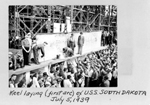 |
176k | The keel laying of the South Dakota (BB-57) on 5 July 1939. | Photo-Courtesy Mrs. Anne Magierski via New York Shipbuilding Company Historical Site. | |
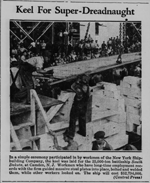 015739 | NR | Keel For Super-Dreadnaught In a simple ceremony participated in by workmen of the New York Ship-building Company, the keel was laid for the 35,000-ton battleship South Dakota (BB-57), at Camden, N. J. Workmen who have long-time employment records with the firm guided massive steel plates into place, bolted and welded them, while other workers looked on. The ship will cost $52,794,000. | Central Press photo. Image and text provided by University of North Carolina at Chapel Hill Library, Chapel Hill, NC. Photo from Henderson Daily Dispatch. (Henderson, N.C.) 1914-1995, 08 July 1939, Image 1, via chroniclingamerica.loc.gov. | |
 |
26k | The South Dakota (BB-57) was a new class of battleship, and was frequently referred to as "Battleship X" so as not to reveal her identity to the Japanese. New York Shipbuilding took pride in their work, with a sign over the yard entrance, which read, "The Birthplace of "Battleship X". | Photo-50 Years: New York Shipbuilding Corporation via New York Shipbuilding Company Historical Site. | |
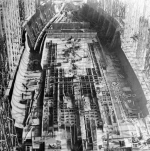 |
151k | South Dakota (BB-57), as seen in late 1939. The double bottom is being plated over and a portion of the holding bulkhead up to the triple bottom is in place. Framing for the outboard wing tank is being worked aft and the bulkheads for the forward auxiliary machinery are being erected. | USN photo courtesy of Mike Green from "Iowa Class Battleships-Their Design, Weapons & Equipment" by Robert Sumrall. | |
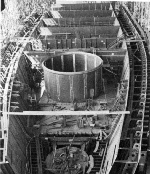 |
106k | Construction progresses of South Dakota (BB-57) on 1 April 1940 looking aft. Visible are foundations for turret 1, barbette for turret 2, auxiliary machinery room, and four combination fire-engine rooms. Wing tank torpedo defense system is clearly shown. | USN photo courtesy of Mike Green from "Leeward Publications/SHIP'S DATA 2, Alabama (BB-60)". | |
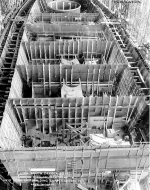 |
189k | Under construction at the New York Shipbuilding Corporation shipyard, Camden, New Jersey, 1 April 1940. This view, taken looking forward from Frame # 115, shows the ship's interior amidships, including six major watertight transverse bulkheads and anti-torpedo longitudinal bulkheads along the sides. Note the inward slope of the side bulkheads, corresponding to the slope of the battleship's side armor. | Photograph Naval History and Heritage Command # 19-N-28532 from the Bureau of Ships Collection in the U.S. National Archives. | |
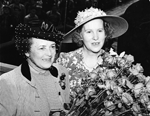 |
478k | Philadelphia, PA. (6 June 1941) Mrs. Harlan J. Bushfield (Left), wife of the Governor of South Dakota, who will christen the battleship South Dakota (BB-57) at the New York Shipbuilding Company, Camden, New Jersey on 7 June was on hand to get some pointers from Mrs. Ralph A. Bard (Right), wife of the Assistant Secretary of the Navy, who christened the Terror (CM-5), the first mine layer built for the Navy, at the launching ceremonies today at the Philadelphia Navy Yard. | Photo created by Acme Newspictures, courtesy of Bill Gonyo. | |
 |
41k | Christening ceremonies of South Dakota (BB-57) on 7 June 1941 at the New York Shipbuilding Corporation of Camden, N.J. | Courtesy of Pieter Bakels. | |
 015730a |
801k | South Dakota (BB-57) inside the way. | Photo courtesy of newyorkship.org. | |
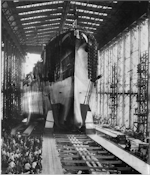 |
164k | South Dakota (BB-57) heads towards Delaware. | Photo courtesy of the George D. McDowell Philadelphia Evening Bulletin Photographs @ digital.library.temple.edu. | |
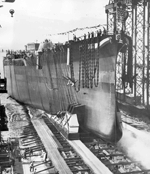 |
819k | Lots of South Dakota (BB-57) on the move. | USN photo submitted by David Buell. | |
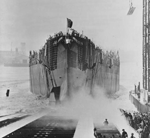 |
107k | A forward looking ship enters the waters in the opposite direction; 7 June 1941, South Dakota (BB-57) touches the waters. | USN photo # 80-G-8804, submitted by Pieter Bakels. | |
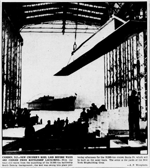 015760k | NR | NEW CRUISER'S KEEL LAID BEFORE WAYS ARE COOLED FROM BATTLESHIP LAUNCHING With the ways still warm from the launching of the 35,000-ton battleship South Dakota (BB-57) (background), the keel was swung into place yesterday afternoon for the 10,000-ton cruiser Santa Fe (CL-60), which will be built on the same ways. The scene is the yards of the New York Shipbuilding Corp. | Image and text provided by Library of Congress, Washington, DC. Photo from Evening Star. [volume] (Washington, D.C.) 1854-1972, 08 June 1941, Image 5, via chroniclingamerica.loc.gov. | |
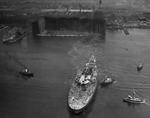 |
303k | 3 photo PDF of South Dakota's (BB-57) first few minutes in the Delaware River, 7 June 1941. Launched from New York Ship, Camden NJ. ISM, Aeroservice collection 21849,21850,21857. | USN photo s courtesy of John Chiquoine. | |
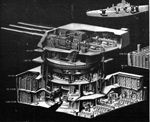 | 2.50k | Main battery | USN photo submitted by Pieter Bakels. | |
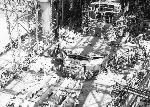 |
590k | Forward turrets of the South Dakota (BB-57) under construction on 1 January 1942. | USN photo courtesy of Pieter Bakels. | |
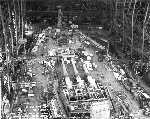 |
722k | After turret of South Dakota (BB-57) under construction on 1 January 1942. Main deck looking aft from frame # 115. Note the 16" shells on deck and the captions labeled on the ammo boxes "The Year Around If You Feel Safe You Feel Good". | USN photo courtesy of Pieter Bakels. | |
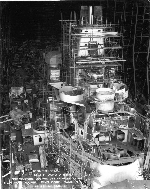 |
465k | Superstructure looking aft from frame 65, 1 January 1942. | USN photo courtesy of Pieter Bakels. | |
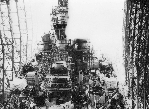 |
411k | View of the main superstructure, stack and secondary armament, 1 January 1942. | USN photo courtesy of Pieter Bakels. | |
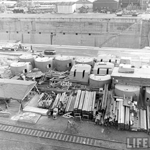 015748a |
683k | Those little things that just might come in handy in case of war: 5" turrets awaiting the South Dakota (BB-57) at Philadelphia Navy Yard, 1942. | Source: United States National Archives photo courtesy of life.com via Yu Chu. | |
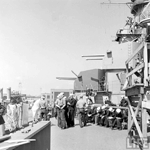 015736 |
479k | Completing fitting out and shakedown training in June, 1942 at Philadelphia Navy Yard. Source: United States National Archives photo. | Source: United States National Archives photo courtesy of life.com via Yu Chu. | |
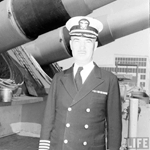 015712a |
460k | Captain Thomas Leigh Gatch became commander of the South Dakota (BB-57) on 20 March 1942. Serving in the South Pacific until December 1942, he distinguished himself in that role in the Pacific Theater of Operations in battles such as the Battle of the Santa Cruz Islands during the Guadalcanal campaign. He received two Navy Crosses for his service and the Purple Heart. | Text courtesy of Bill Gonyo. Source: United States National Archives photo courtesy of life.com via Yu Chu. |
|
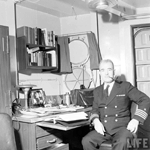 015704e |
526k | Captain Thomas Leigh Gatch in June, 1942 at Philadelphia Navy Yard. | Source: United States National Archives photo courtesy of life.com via Yu Chu. |  |
539k | South Dakota (BB-57) is leaving Philadelphia on 4 June 1942 for her shakedown training to 26 July. | USN photo courtesy of Pieter Bakels. |
 |
964k | Port Quarter View, Phila. Navy Yard 4 June 1942. | USN photo courtesy of Pieter Bakels. | |
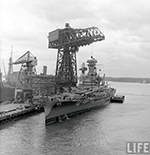 |
656k | South Dakota (BB-57) completing fitting out and shakedown training in June, 1942 at Philadelphia Navy Yard. | Source: United States National Archives photo via Mike Green. | |
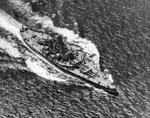 |
952k | Summer of 1942. She is still armed with her designed A.A. armament and was the only of the class that carried this armament. Also unique to the South Dakota (BB-57) is the fact that she only mounted eight twin 5"/38 mounts, four to a side. The rest of the class were armed with the standard ten twin mounts. The South Dakota was designed as a fleet flagship from the outset, so she sacrificed two 5" mounts for flag officer space. | Official USN photo Naval History and Heritage Command # 80-G-466247, now in the collections of the National Archives. | |
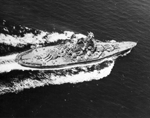 |
563k | Underway in the Atlantic during her shakedown period, 22 July 1942. | Official USN photo Naval History and Heritage Command # 80-G-466248 courtesy of Pieter Bakels. | |
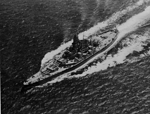 |
2.77k | Port beam view while underway in the Atlantic, 22 July 1942. | USN photo BuAer #19079 from NARA, College Park, Maryland, courtesy of Sean Hert. | |
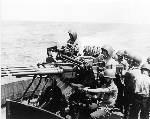 |
219k | Gun crew with 1.1-Inch, 75-Cal. 'on station' aboard the South Dakota (BB-57), during her shakedown. | USN photo submitted by Pieter Bakels. | |
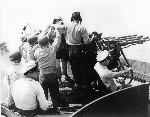 |
200k | Firing the 1.1-Inch, 75-Cal.gun aboard the South Dakota (BB-57), during her shakedown. | USN photo submitted by Pieter Bakels. | |
| August - October 1942 / Battle of the Santa Cruz Islands |
||||
 |
56k | The anti-aircraft battery pumping out shells at the Battle of Santa Cruz, 26 October 1942. | USN photo. | |
 |
54k | Battle of the Santa Cruz Islands, October 1942. South Dakota (BB-57) firing her anti-aircraft guns at attacking Japanese planes during the action, 26 October 1942. A Japanese Type 97 Shipboard Attack Aircraft ("Kate") is at right, apparently leaving the area after having dropped its torpedo. A high resolution photo can be seen here. |
Official USN photo # Naval History and Heritage Command # 80-G-30054, from the collections of the Naval Historical Center. High res photo courtesy of newyorkshipbuildingcorporation.files.wordpress.com newyorkshipbuildingcorporation.files.wordpress.com. |
|
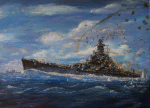 |
90k | A painting by the artist Wayne Scarpaci depicting the Battle of the Santa Cruz Islands, October 1942. U.S. Navy ships firing at attacking Japanese carrier aircraft during the battle, 26 October 1942. Enterprise (CV-6) is at left, with at least two enemy planes visible overhead. In the right center is South Dakota (BB-57), firing her starboard 5"/38 secondary battery, as marked by the bright flash amidships and at least one Japanese plane falling in flames. | Drawing courtesy of artbywayne.com. | |
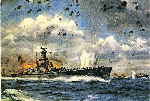 |
502k | A painting by Navy Combat Artist Dwight Shepler entitled "Air Defence, Battle of Santa Cruz", depicts the South Dakota (BB-57) helping to wither away a determined Japanese dive-and torpedo bomber attack. | Submitted by Pieter Bakels. | |
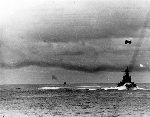 |
86k | "Battleship 'X'" - the South Dakota (BB-57) - and a destroyer maneuver at high speed during the Battle of Santa Cruz, 26 October 1942. | USN photo courtesy of United States Naval Institute via Joel Shepherd & cv6.org, submitted by Mike Green. | |
 |
3.6m | Val divebomber goes down in flames as a near-miss rocks the Enterprise (CV-6). Note the South Dakota (BB-57) racing along, her AA guns smoking. South Dakota, radically, unpredictably manoeuvring within 1000 yards of the carrier Enterprise where her powerful defensive armament of 10 newly fitted 40mm quadruple mounts, replacing the unsatisfactory 1.1-inch guns, each automatically following a remote (MK.51) director which had a tachometric aiming sight (Mk.14) and an increased number of 20mm Oerlikon's, withered away a determined Japanese dive-and torpedo bomber attack, probably saving the carrier, shooting down a few dozen Japanese aircraft. At one point South Dakota was about 2000 feet away from Enterprise when a Jap plane flew between both ships. That pilot had a lot of guts and knew his trade and, as he was flying by, both ships let loose with their 40-and 20mm guns. South Dakota was hitting the Enterprise and the Enterprise was hitting us, wrote Bestard Efrain. Donald C.Guelich, QM 3C saw a Japanese torpedo plane coming in on the starboard side, launching its torpedo. It rode through the sea and passed close by the stern. Another 20 feet and the battleship would have lost rudders and propellers. Wayne Holbrook was a rangefinder operator in Secondary Battery Director #1 for the 5-inch/38 mounts. He wrote: "A Japanese torpedo plane was coming in through a maze of bursts from 20mm, 40mm and 5-inch guns. I could see the pilot and the torpedo strapped under the plane. The plane just kept coming; the pilot must have been hit. Finally, the nose of the plane went up in the air and I could see the colored stripes painted on the torpedo. One of the straps let go and it swung like a pendulum and went straight down, harmlessly in the sea, not 2000 yards from the ship". The ship received a direct hit from a 500-pound bomb on top of Main Battery Turret # 1. It did not penetrate but deformed two of the three 16-Inch barrels of #2 turret. Flying shrapnel damaged a 40mm quad and hit Captain Gatch standing on the catwalk of the bridge, wrote Donovan D. Graham, assigned to the Deck Division aboard South Dakota. |
USN photo & text submitted by Pieter Bakels. | |
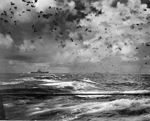 |
811k | Battle of the Santa Cruz Islands, October 1942. U.S. Navy ships firing at attacking Japanese carrier aircraft during the battle, 26 October 1942. Enterprise (CV-6) is at left, with at least two enemy planes visible overhead. In the center is South Dakota (BB-57), firing her starboard 5"/38 secondary battery, as marked by the bright flash amidships. | Text courtesy of Naval History and Heritage Command # 80-G-20989, courtesy of Pieter Bakels. | |
 |
86k | Battle of the Santa Cruz Islands, October 1942. Attack on the Enterprise (CV-6). One plane is pulling out and heading for the South Dakota (BB-57). | USN photo # 80-G-33345, submitted by Pieter Bakels. | |
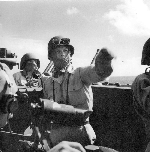 |
108k | A gun captain points out a Japanese Kate torpedo bomber moving in to launch a torpedo. | USN photo submitted by Pieter Bakels. | |
 |
28k | A Kate torpedo bomber races for its target just before being hit. It burned and crashed into the sea without hitting. | USN photo courtesy of Pieter Bakels. | |
 |
152k | Members of a 16-Inch turret crew looking through periscope for a view of the outside action. | USN photo courtesy of Pieter Bakels. | |
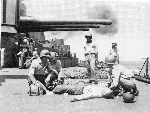 |
61k | The Medical Corps comes to the aid of a wounded crew member. | USN photo submitted by Pieter Bakels. | |
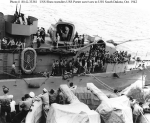 |
111k | Shaw (DD-373) transferring survivors of Porter (DD-356) between Shaw and South Dakota (BB-57), on 28 October 1942. Porter had been torpedoed and sunk two days earlier, during the Battle of the Santa Cruz Islands. Photographed from on board the South Dakota, one of whose 40mm quad gun mounts, covered with canvas, is in the foreground. | Official USN photo # Naval History and Heritage Command # 80-G-33381, from the collections of the Naval Historical Center. | |
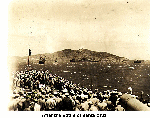 |
62k | South Dakota (BB-57) after the Santa Cruz air battles, taken from what appears to be the Washington (BB-56). | USN photo courtesy of Pieter Bakels. | |
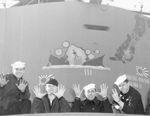 |
351k | The ship's company signal a tally for the action at Santa Cruz. | Courtesy of Pieter Bakels. | |
| November 1942 / Guadalcanal & Fourth Battle of Savo Island |
||||
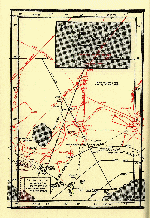 |
5.00k | PDF Action report of the Battleship Night Action between the U.S. and Japanese forces off Savo Island on November 14-15, 1942.
The following text by Pieter Bakels is a summation of the battle. At 2300 exactly on the night of 14-15 November 1942, the "SG" surface search radar of the battleship Washington (BB-56), following the destroyers Walke (DD-416), Benham (DD-397), Preston (DD-377) and Gwin (DD-433) with another battleship astern, the new South Dakota, began tracking a target, bearing 340T, broad on the starboard bow, distant eighteen thousand yards. The main battery Directors of Washington trained towards the larger of two targets, the Japanese cruiser Sendai under the command of Rear Admiral Hashimoto. Within seconds the range-keeper had a firing solution and Washington's three Main Battery turrets swung to starboard, guns elevated for a range of eleven thousands yards. "Commence Firing!" was ordered at 2317 and "all hell broke loose", as Washington blasted a nine–gun salvo at Sendai, Hunter Cronin in Secondary Conn, ("Battle 2") wrote. Shikinami, the second target was taken under fire by the battleship's starboard Secondary Battery directed by "Sky 3". One minute later, South Dakota rained down shells on the destroyer Shikinami. Aboard South Dakota, William P. Gray was assigned to Main Battery Fire Control Maintenance and Operations. His battle station was Main battery Director #1 as Director Captain/Pointer. He wrote in his memoirs: "The first Main battery action, Savo Island, first sighting of enemy warships. We were ordered to pick out the biggest and commence firing. The closing of Main Battery. Firing key against enemy warships for the first time. Shells on the way and Spotting Officer calling: "No change! No change!" Her bridge and spotting personnel saw Shikinami roll over and sink according to the Action Report. However, Sendai and Shikinami retired in a loop behind a smoke screen, disappearing from view and radar in the closely confined waters of "Ironbottom Sound". When the two Japanese ships retreated behind their smoke screens, the destroyers Walke, Benham, Preston and Gwin opened fire on them and on blobs of light, coming from the direction of the shoreline of Savo Island. The Japanese had not emplaced batteries on Savo but the fire was coming from the destroyers Ayanami and Uranami, sent west around Savo; within their wake the cruiser Nagara (Rear Admiral Kimura) and the destroyers Teruzuki, Inazuma, Shirayuki and Hatsuyuki. The duel was short, ferocious and uneven. Unskilled in night fighting and saving their torpedoes for bigger stuff, the US destroyers opened up with their guns, Gwin firing starshell to illuminate the scene. Japanese spotters used their gun flashes as fine aiming points. The destroyers Ayanami and Uranami each fired a torpedo spread at Gwin but none hit. However at 2330 Walke, the lead ship, began taking hits from 5- and 5.5-inch and fell off to port and took a torpedo eight minutes later in her starboard side, blowing off the forward part of the ship. "Abandon Ship" was ordered at 2345. Depth charges rolling off their tracks and exploding, killed its Captain and many of her hands as they cleared the ship. The enemy cruisers rained down explosives on Benham, Preston and Gwin and a salvo from Nagara reduced Preston to a wreck and on 2336 she too had to be abandoned with 116 killed. Then Gwin got hit, taking a pair of 5-inch shells, one in the after engine room and one on the fantail. Her guns continued firing in local control. Benham took a torpedo in her starboard bow that blew most of it away but limped on with reduced speed, her guns firing rapidly. Walke and Preston were enveloped in fire, their crews struggling in the oily water in the path of Washingtonand South Dakota. At 2333 the South Dakota went blind and deaf due to a circuit overload and steamed on behind Washington towards the crippled Benham. Ivant Musicant in his book "Battleship at War" wrote that there was bad blood among the crews of the battleships South Dakota and Washington after the night action of 14-15 November 1942, fought to prevent the final attempt of the Japanese navy to recapture Guadalcanal. The Washington's sailors with a sneer declared war between the ships and enlisted men actually engaged in combat on the beaches at Noumea, calling the battleship South Dakota "Shitty Dick" after that battleship retired from the fight badly cut up, unable to communicate. Admiral Lee furiously dictated in a special order of the day that "One war at the time is enough!" and had the liberty days of the two ships staggered. The South Dakota's Commanding Officer, Captain Gatch and his senior officers were ordered to report aboard Washington to go over the battle. There it was learned that the South Dakota's Chief Engineer, contrary to established procedures, had tied down her circuit breakers, which had the effect that of putting the whole electrical system in series. The concussion of 5-Inch hits and internal shocks of firing her own batteries overloaded the circuits and everything went out- radar, fire control stations, turret motors, ammo hoists and radio's, leaving South Dakota blind. William A.Hughes wrote how a ship mate, may have saved his ship (South Dakota). On the evening of 14 November 1942 William Hughes was switchboard operator on # 1 switchboard. South Dakota had 4 switchboards, each controlling two 1000 KW generators. An unknown ensign and a Chief Electrician's Mate, Shaeffer, were there. Electrician's Mate I.C. Lusk was a telephone talker with the After Repair party stationed on the second deck on the port side by the barbette of # 3 16-Inch turret. When South Dakota took a hit to a large power panel mounted on that barbette it probably caused a short circuit to # 4 switchboard and caused her circuit breakers to kick out. All switchboards were operating independent of each other. Someone panicked, he wrote, either the switchboard operator or one of the Engineering Officer's who were stationed at # 3 Engine Room. Orders were given to close the bus-ties between # 4 and # 3 switchboards and this knocked off # 3 switchboard which in turn closed it's bus-ties to # 2 switchboard and # 2 went off the line. (A bus-tie is a circuit breaker that ties two or more switchboards). No one, but my Chief, Hughes wrote, realized what was happening and how to cure the problem. Against direct orders he ordered to hold the bus-ties to # 2 switchboard open, so that the other three switchboards could not tie in. "If I had let them tie in, he wrote, we would have lost our power, leaving the ship with a total loss of power and would have ended up dead in the water and at the mercy of the enemy. The Chief then told the ensign to tell the Chief Engineer to clear the problem of # 4 switchboard and then he would allow Hughes to close the bus-ties and restore power back to the ship. That Chief never got credit for saving the lives of the crew and the ship. Ray Hunter on Washington's bridge, hearing that all communication with South Dakota had been lost, watching the burning remains of Walke and Preston ahead and hundreds of men swimming about, told the helmsman: "come left!" his exact words he later wrote. He then straightened out on a parallel course to the one they were steaming. Leaving the burning destroyers to port and keeping them between Washington and the enemy, he avoided being silhouetted by the fires, an easy target. Dozens of men could be seen in the burning water, clinging to wreckage and life rafts were thrown at them. South Dakota, silent now for three minutes, didn't follow in Washington's wake but sheered off to starboard of the sinking destroyers and presented an excellent silhouette. At once, Hashimoto and Kimura's searchlights illuminated the South Dakota's superstructure. Nagara and four destroyers launched a spread of thirty-four torpedoes at point-blank range but none found their mark. Washington's 5-inch mounts shot out the lights and took Nagara under fire and when her lights went out, switched fire to the accompanying destroyers, illuminating South Dakota. South Dakota began taking hits topside. Savo Island's land mass made radar tracking difficult and the flash-less powder that the Japanese used provided only small aiming points. South Dakota now had restored part of her electrical power and her guns were firing, but she was still unable to communicate with Washington. Arthur A. Aldred's battle station was at the starboard 40mm quad on the fantail. Early in the action the 40mm crew was ordered to take cover forward of the # 3 16-inch turret because it was going to train around and fire at a target directly astern. He had just taken cover when a salvo was fired and instantly the fantail was ablaze. The muzzle blast had demolished and ignited the three Kingfisher catapult planes. "Had we not taken cover", he wrote, "most of us would have suffered the same fate." The Japanese now had a new aiming point and their fire came in fast. The next 16-inch salvo blew the burning Kingfisher overboard. At 2340 Admiral Kondo with his main body came up with two destroyers, the cruisers Atago and Takao and the Battleship Kirishima. Washington had a fire solution for the biggest target, Kirishima within seconds but checked fire, afraid to hit South Dakota, last seen somewhere aft to starboard. At 2345 Benham and Gwin, making best speed were ordered to retire out of the way. At 2355 fire was resumed. Kondo's ships tracked South Dakota, passing inboard of the smoldering Walke and illuminated her again. Two destroyers launched a torpedo attack but none hit. The Japanese gunners on Kirishima, Atago and Takao at a range of fifty-eight hundred yards did and South Dakota took multiple hits in her superstructure and topside damage was considerable. South Dakota replied with her 16-inch and hit Atago and Takao. However, within five minutes her radar plot was destroyed, radio communication was out and four out of six fire control radars. The #3 16-inch turret had taken a 14-inch hit outboard of the roller path and locked in train. Gunnery stations took casualties, small fires raged in the upper-works and oil was leaking from a ruptured fuel line. Washington's location was not known to her, according to her reports and it was decided to withdraw to the rendezvous assigned by the Task Force Commander prior to the engagement. She had suffered forty-two hits, thirty-eight men were dead and sixty wounded. Just before midnight a target, first thought to be a cruiser, illuminated South Dakota. The target was Kirishima, broad on the Washington beam, at a point-blank range of eighty-four hundred yards. At exactly midnight permission was given to open fire. Washington's nine-gun salvo straddled Kirishima while her Secondary Battery began firing star shells. A hit was reported on the enemy's superstructure and the third 16-inch salvo landed squarely amidships, causing bright explosions. South Dakota was still under fire from Atago and Takao and Washington's 5-inch mounts were directed against the two cruisers and shot out their searchlights, placing hits on superstructures and fires broke out on Atago. Washington's turn to the left had made her invisible in the loom of Cape Esperance, taking the Japanese by surprise. A report was received from Sky Control that the big target was sunk and fire ceased for ninety seconds. Kirishima checked her fire on South Dakota, leaving her to the other Japanese ships and trained her turrets towards Washington. The first salvo was a short, short, over and over. Their second salvo: over-short-on. The Japanese, steaming parallel to Washington launched another torpedo spread and thirty-two separate reports of tracks were sent to Washington's bridge, one of them probably hit the debris from a sinking destroyer and blew up. Kirishima, Atago and Takao had altered course 180 degrees and were now steaming away from Washington, north-eastwards, broad on the starboard quarter. Washington resumed fire and hit Kirishima, smothering her with fire from both 16-inch and 5-inch. One by one her turrets were knocked out. Finally only the after turret continued firing and she began to glow dull red amidships, brightening up as she took more hits. At 0007 Washington, left alone, fired the last salvo at Kirishima, now a mass of flames with her underwater hull damaged by near misses, taking on water and listing to starboard. Out of control and her steering gear shot away, she was steaming in circles. "Cease fire" was given for the 5-inch guns since they had reached the limit of after train. There were still multiple targets, but doubt still existed on the whereabouts of South Dakota and Washington's surface search radar could not see astern. Unable to contact South Dakota, Washington steamed on alone. After steaming five miles on course 340T, radar reported contacts off the port bow. They were the destroyers Kagero and Oyashio launching a spread of torpedoes. Washington, sighting their smoke screen, reversed course 180 degrees at twenty-six knots, throwing up an enormous wake. She needed a good two minutes to settle in on her new course during which various lookouts spotted torpedo tracks, four or five of them very close and exploding in Washington's wake. At 0044 Admiral Lee ordered Washington to steer generally southwest and she zigzagged back and forth on her base course, spotting another torpedo blow up in her wake. At 0951 lookouts sighted South Dakota again, receiving her signal that she was not effective and she was leaking oil. Captain Gatch was ordered to take station ahead of Washington. The ships went to general quarters again after sightings of unidentified aircraft to port which later turned out to be friendly. The big question is: why did South Dakota turn to starboard, not following Washington, exposing herself to illumination by the burning destroyers, an easy target for the quick reacting experienced Japanese gunners? I will not judge the men of South Dakota, seeing the survivors of their destroyers in the burning water, fellow Americans, going into harm's way, bringing their ship between them and an enemy, still firing on the hapless destroyers and the men in the water. Secondly, by doing so, they attracted the attention of the Japanese, bent on the destruction of that ship, as their naval aviators had done before when they slaughtered the hapless "Devastators" of VT-3, VT-6 and "VT-8 " under Lt Cmdr John C. Waldron at Midway, but their sacrifice was not in vain! It cleared the way for the final move, unexpected by both the American and the Japanese high command, that would cost them four carriers and their irreplaceable crews when CEAG: LCDR C. Wade McClusky led a total of thirty-seven Dauntless dive bombers from Enterprise (CVA-6) down to attack the enemy carriers, joined by VB-3 from Yorktown (CVA-3). With the Zeros all at low level after dealing with the "Devastators" the SBD's had begun their attacks unhindered by enemy fighters. And, just like McClusky, for some time, Washington could fire unobserved! Judging from the quick reaction of Sendai and Shikinami, faced with a battleship raining down shells on them, Washington was very lucky! |
USN photo courtesy of Pieter Bakels. Majority text courtesy of Charles Carpenter, Cdr. Dart,USN (Ret.) & Pieter Bakels. Partial text source: Fleets of World War II by Richard Worth. Film of Torpedo 8 in color by John Ford, courtesy of torpedoeight.com. Inset photo of damaged Japanese destroyer courtesy of Arnold Putnam. |
|
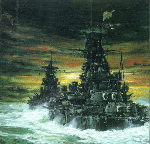 |
655k | Kirishima and sister Hiei trailing on 13 November 1942: The First Naval Battle of Guadalcanal. The barbette hit on the South Dakota by the 14" shell from Kirishima was almost at right angles and with a small downward angle. The shell tore a rather large hole in the **1.5"-thick** STS (armor-grade steel) weather deck and **DENTED** the 17.3" Thick-Chill (55% (circa 9") hard face thickness!!) curved Class "A" barbette side plate!!! No "AA" round such as the **WOODEN-NOSED** and very-thin-cased Type 3 incendiary/shrapnel shell or even a nose-fused Type 0 HE shell could do that -- the former could not even penetrate a US heavy cruiser barbette, San Francisco (CA-38) in this case, while the latter would blow up instantly and make no more than a scratch on the surface as it disintegrated sideways and, while its fragments *could* punch many small holes in the 1.5" deck under it, they definitely could NOT tear it open (the torn, bent-down deck plate had NO small holes in it when seen from underneath in a photograph taken from the deck below, so this damage was NOT caused by small pieces of an exploded Type 0 HE shell). The only shell left is a 14" (36cm) Type 91 AP shell (1480-lb) with its very long delay (0.4-second) delay-action base fuse and circa 22 lb of sensitive TNA filler (about a third of the cavity was made of cushioning material to protect this filler on impact; the Japanese wanted the most powerful explosive that they could get and compromised on filler size to get it, for some bizarre reason I cannot fully comprehend). The shell hit at a very shallow downward angle, tore a half-moon out of a raised sheet-metal hatch casing in front of the barbette and then hit the deck a couple of feet in front of the barbette, tearing up the teak deck and slamming into the barbette just below the weather deck level, leaving a dent (with a small "dimple" in the center) in the barbette plate and generated a series of concentric hairline cracks in the barbette surrounding the impact point (these are also visible on that same below-deck-looking-up-into-the-weather-deck-hole photo). The impact with the deck at this high obliquity pushed the deck down and projectile nose up slightly and tore the deck free of its heavy under-deck supports just outside of the barbette (it was not touching the barbette since you cannot anchor anything to the face of a Class "A" plate) and knocked off the AP cap, which was pulverized between the projectile nose and the barbette on impact, but no longer protected the projectile nose properly. The nose shattered, preventing penetration, and the projectile stood on its head as it reflected off of the barbette in a downward (and slightly to the left) direction. It began to move downward slowly (compared to how fast it was going before) and its base rotated around and slammed into the barbette just below the lower edge of the turret (directly under the middle gun of the turret, which was aimed at the Japanese ship that fired the shell we are discussing). This WHAMMMM!!! up against the rigid barbette added to the dent and left a second scar on the barbette just below the turret ring. It also caused the sensitive TNA filler to detonate and this ripped up the wooden deck over a wide area around the impact site, but did virtually nothing to the STS weather deck itself (the blast was directed parallel to the deck radiating from the barbette, not into the deck). The nose of the shell had by this time torn open a rather wide mouth-shaped opening between the dented deck and the barbette face (like a huge crowbar) and large pieces of the now-broken-up projectile tore into the one-deck space between the main armor deck and the weather deck, making many large and small holes in vertical bulkheads over rather a large area between the decks, though the main armored deck under the hole was hardly scratched. Thus, the impact was a potential disaster to the South Dakota if the shell had hit slightly higher and had its AP cap intact when it hit the plate. It might actually have penetrated in this case -- iffy, but barely possible -- and would most definitely have jammed the turret permanently until the ship went back an overhaul facility and had the damaged plate replaced and the internal barbette parts fixed. The decapping by the deck impact thus prevented all but rather minimal damage to the ship (the hit turret was still functional, if somewhat slow to move in train). HE shells are light-cased shells and, when combined with instantaneous nose fuses (the only one used in the Type 0 HE shell), will do very little to even thin armor plate: For example, a 16" 1900-lb Mark 13/14 instantaneous-nose-fused ("PDF") High Capacity (HC) US Navy WWII shell CANNOT penetrate 3" of homogeneous armor!!! It makes a big dent, but the shell destroys itself before its nose tip can move more than a few inches forward -- against a 17.3" Class "A" plate the effects would hardly be noticeable (definitely no dimple in that circa 9" of rigid face layer!!!). The holes it makes in thin homogeneous plates to the sides (such as the STS deck plate mentioned above) are caused by many small pieces of the shell moving VERY fast at close range due to the large detonating filler and look like a leaf partially eaten by many small caterpillars (lots of small holes and crescent-shaped cut-outs in larger torn openings). Tearing open a rather thick STS plate over a wide area, as happened here, by a filler explosion alone without making such small holes too (at least directly under the impact point, if nowhere else) is not possible: An HE gun projectile simple does not have enough explosive in it -- only circa 80-lb of TNA explosive in this case -- to do such a thing when not confined (this was an open-air explosion) against such a relatively thick STS plate (a downward bulge and popping rivets/bolts, yes; tearing the plate itself like a sheet of paper and bending it down so that the bent edge was actually vertical over a length of about 10' centered on the impact point, no). Also, the hit on that hatch casing or the deck would have almost certainly set off a nose fuse in an HE shell prior to reaching the barbette, so only some small projectile chunks would have reached the barbette directly, causing no damage whatsoever to the barbette internal fittings (a **REALLY** SOLID hit by an BIG **INTACT** shell would be needed to dent that armor, as mentioned above). The external damage above the weather deck to the turret gun barrels and so forth would be roughly the same, but no large opening in the weather deck (some holes directly under the blast point and a big dent, probably), and much less damage in the space below the weather deck. |
Photo courtesy of Pieter Bakels. Text courtesy of Nathan Okun via Pieter Bakels. | |
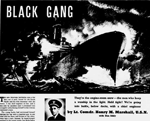 015743g | NR | BLACK GANG 2 page PDF of the engine room perspective of South Dakota (BB-57) during Guadalcanal action, November 1942, by Lt. Comdr. Henry M. Marshall, U.S.N. | Image and text provided by Library of Congress, Washington, DC. Photo from Evening Star. [volume] (Washington, D.C.) 1854-1972, 25 April 1943, Images 77 & Image 78, via chroniclingamerica.loc.gov. | |
 015743f | NR | Battleship's First Surface Fight At Savo Described by Crewmen 'Here I Am Dead' Lookout's First Thought On Regaining Consciousness | Image and text provided by Library of Congress, Washington, DC. Photo from Evening Star. [volume] (Washington, D.C.) 1854-1972, 30 April 1943, Image 3, [volume] (Washington, D.C.) 1854-1972 & Image 78, via chroniclingamerica.loc.gov. | |
 |
170k | The battleship Washington (BB-56) in the lead with the South Dakota (BB-57) trailing in the second night battle of Guadalcanal (14-15 November 1942) from a painting by Lt. Dwight Shepler, USNR. | Courtesy of Pieter Bakels. | |
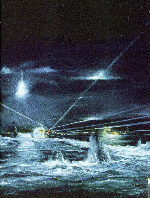 |
890k | The battleship Washington (BB-56) leading South Dakota (BB-57) while firing at Kirishima on the night of 14-15 November 1942. | Courtesy of Pieter Bakels. | |
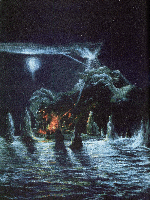 |
902k | The Japanese battleship Kirishima takes hit after hit from Washington (BB-56) as the battle reaches its climax. | Courtesy of Pieter Bakels. | |
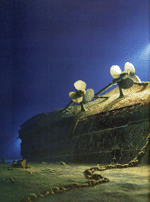 |
2.10k | The Japanese battleship Kirishima resting with her bow and the tip of her stern gone. | Courtesy of Pieter Bakels. | |
 |
653k | The one remaining Kingfisher aboard South Dakota (BB-57) as it looked after her #3 Main battery Turret blasted the other two overboard during the battle. | Courtesy of Pieter Bakels. | |
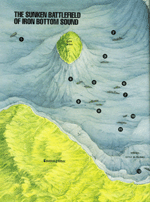 |
2.40k | Artist rendering of the approximate positions of the thirteen discovered sunken ships lying in 2,000 feet of water at Iron Bottom Sound. | Courtesy of Pieter Bakels. | |
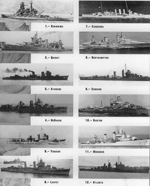 |
2.10k | The thirteen wrecks at the bottom of the Sound. | Courtesy of Pieter Bakels. | |
 |
683k | The waters now off Savo island. | Courtesy of Pieter Bakels. | |
 |
462k | Prometheus (AR-3) ties alongside of the South Dakota (BB-57) and two destroyers for repairs after the second night battle of Guadalcanal (14-15 November 1942). | Courtesy of Pieter Bakels. | |
 |
35k | Battle damage aboard South Dakota (BB-57) after the second night battle of Guadalcanal (14-15 November 1942). | Courtesy of Pieter Bakels. | |
 |
201k | Captain Gatch, his arm still in a sling, leads a memorial service after the battle. | Courtesy of Pieter Bakels. | |
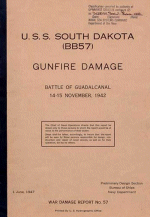 |
2.78k | Cover of the 41 photo PDF of the damage report inflicted on the South Dakota (BB-57) during the battle at Guadalcanal, 14 - 15 November, 1942. Published 1 June 1947. | Photo from WII War Damage Reports, courtesy of NavSea / dcfp.navy.mil, link submitted by Mike Green. | |
 |
267k | Plate No. I showing gunfire damage report inflicted on the South Dakota (BB-57) during the battle at Guadalcanal, 14 - 15 November, 1942. Published 1 June 1947. | Photo from WII War Damage Reports, courtesy of NavSea / dcfp.navy.mil, link submitted by Mike Green. | |
| December 1942 - July 1943 / War in the Atlantic |
||||
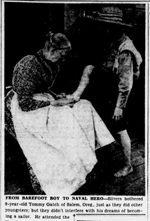 0157tgc | NR | FROM BAREFOOT BOY TO NAVAL HERO Slivers bothered 9-year-old Tommy Gatch of Salem, Oreg., just as they did other youngsters; but they didn't interfere with his dreams of becommg a sailor. He attended the Naval Academy, was commissioned and now is Capt. Thomas Leigh Gatch, commander of the battleship South Dakota (BB-57), credited with destroying 32 Japanese planes that attacked a flotilla of which his craft was a unit. The woman probing for a splinter was Mrs. Sarah West, mother of Tommy's friend. Oswald West, who later became Governor of Oregon. | A .P. Photo Image and text provided by Library of Congress, Washington, DC. Photo & text by Evening Star. [volume] (Washington, D.C.) 1854-1972, 08 January 1943, Image 33, via chroniclingamerica.loc.gov. | |
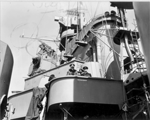 |
377k | After her night ordeal off Guadalcanal, South Dakota (BB-57) returned to the United States and arrived at the N.Y. Navy Yard on 18 December 1942. Repairs were completed on February, 1943. Her new skipper, Captain Lynde D. McCormick, USN., took her to Portland, Maine and on to Argentia, Newfoundland. At Argentia, RADM. Olaf M.Hustvedt, USN., came aboard ("Sodak") as Commander Task Force 61, consisting of South Dakota, Alabama (BB-60) and five destroyers. Task Force 61 arrived at Scapa Flow in the Orkneys off Scotland in May and operated with the British Home Fleet during June and July 1943. Captain Mc.Cormick was relieved by Captain Allan E. Smith, USN after ("Sodak") returned to Norfolk for 10 days. The two officers are probably RADM Hustvedt and Captain McCormick. |
Text & USN photo courtesy of Pieter Bakels. | |
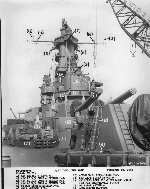 |
511k | The South Dakota (BB-57) view looking aft showing alteration on 20 February 1943. "Note the "SN", a lightweight portable radar set by General Electric, for emergency use aboard ships atop #2 turret. Detection of a battleship at 6 nm., a surfaced submarine at 2nm. The antenna was a 48in paraboloid. Manual scan only. Feed by a vertical dipole. Note the large spotting glass atop the Fire Control tower with the Main Battery Fire Control Radar Mk.3 Mod.2 ("FC") behind it. "FC" had a 12ft x 3ft antenna and operated at a short wavelength (40cm) which gave it good resolution and introduced lobe switching, a process by which bearing was refined by switching the signal alternately between horizontal halves of the aerial and comparing the returns until they were approximately equal. This radar was not employed only for fire control but also as a back-up search set, at night and in poor visibility. It was then used to sweep the horizon every 15 or-so, minutes looking for formation changes etc. This radar proved effective against single low-flying aircraft at 3,500 yd and formations at 10-12,000 yd. It could be diverted back to its original purpose, fire control, at any time. In this role, an accuracy of 50 yd at a range of 23,000 yd on a destroyer was reported. Also note the "FD" (Mk.4) radars atop the three (of 4) Mk.37 Dual Purpose directors. This radar equipment had essentially the same electronics as the "FC" (Mk.3), except that the two radar halves were stacked vertically. The aerial was aligned to the optics of the Mk.37. A range of 40,000yd was reported for a single aircraft at medium altitude, 30,000yd for an aircraft at low altitude and 26,000 yd on a destroyer or cruiser. |
USN photo courtesy of Pieter Bakels. | |
 |
234k | Starboard side view after 1st. refit in February 1943. | Photo i.d. courtesy of Massimiliano Stola. USN photo courtesy of Pieter Bakels. |
|
 |
950k | Aerial View, following repairs at the New York Navy Yard, February 1943. | USN photo courtesy of Pieter Bakels. | |
 |
454k | Probably taken in US waters around February 1943 - one of a large series of photos following her first refit, after war damage in the Pacific, just before leaving for the Atlantic. The expanded Machine Gun Battery and additional electronics is shown. She still has the SC-2 on her Foremast radar platform and SG in front of the splinter-shield surrounding her Forward Air Defense Level just below Spot I, the massive, diamond-backed Mk.38 Main Battery Director with atop the early Mk3 Main Battery fire control radar and a second set atop her Conning Tower, Spot 3, fitted with an extra level for duty as a Flagship. As noted earlier, weight compensation for this extra level dictated the elimination of a 5"/38 gun house on both sides. This cleared space P/S, for a 40mm quad mount with a Mk51 director tub to the right, behind it, just aft and below the Mk.37 director with Mk4 Secondary Battery fire control radar atop. Note that she now has the later Mark 8 radar atop Spot II, the aft Main Battery fire control tower and the extensive use of whip antennas in place of standing rigging previously used. Note also the large stove pipe IFF antennas on her Foremast port- and Mainmast starboard yardarm. The General Electric`SN`lightweight portable radar set for emergency use, visible on later photos taken at Scapa Flow, atop Main Battery Turret #2 is not there yet. Another addition is the high spray shield around the ventilators below her after Mk37 director with stacked 25-life-rafts below them and the extensive use of rolled floater nets, reflecting the lessons of the Solomons campaign and another quad 40 and its director in front of them. |
USN photo courtesy of David Buell. Text courtesy of Pieter Bakels. |
|
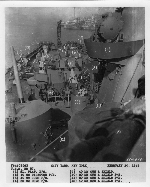 |
302k | Top side view looking aft showing alterations on 20 February 1943. | USN photo courtesy of Pieter Bakels. | |
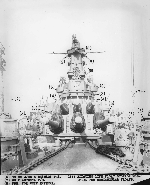 |
331k | View fwd.,looking aft showing alterations on 20 February 1943. | USN photo courtesy of Pieter Bakels. Photo fix courtesy of Tom Kermen. |
|
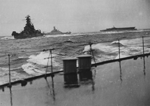 |
417k | South Dakota (BB-57) and Alabama (BB-60), 1943, with the British Home Fleet in the Atlantic. | USN photo courtesy of Pieter Bakels. | |
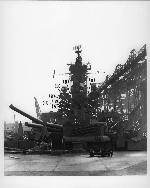 |
292k | Deck view aft, looking forward showing alterations on 20 February 1943. | USN photo courtesy of Pieter Bakels. | |
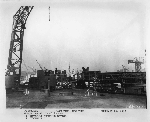 |
197k | Stern view showing alterations on 20 February 1943. | USN photo courtesy of Pieter Bakels. | |
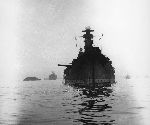 |
287k | Bow on view after first refit in 1943. | USN photo courtesy of Pieter Bakels. | |
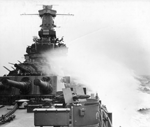 |
391k | Bearing the Atlantic cold, 1943. | USN photo submitted by Pieter Bakels. | |
 |
187k | Navy photo probably taken in the North Atlantic sometime circa mid 1943. | USN photo i.d. courtesy of Jeff Spencer & Aryeh Wetherhorn. | |
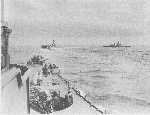 |
77k | Gun crew aboard South Dakota (BB-57) on sortie from Norwegian Coast. Ahead are HMS Unicorn and HMS Duke of York. | USN photo submitted by Pieter Bakels. | |
 |
93k | South Dakota (BB-57) in the Atlantic, exercising with British Swordfish torpedo planes, 1943. | USN photo courtesy of Pieter Bakels. | |
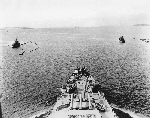 |
165k | The South Dakota (BB-57) proceeds through sub-nets at Scapa Flow - 1943. | USN photo courtesy of Pieter Bakels. | |
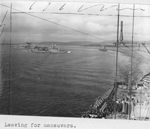 |
769k | Alabama (BB-60) & South Dakota (BB-57) at Scapa Flow. Leaving for maneuvers. Proceeding through the sub nets to the sea. |
USN photo # 80G-319289 (319291 insert) from National Archives and Records Administration (NARA), College Park, Maryland, courtesy of Sean Hert. | |
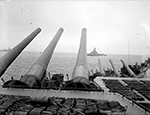 |
368k | Alabama (BB-60) anchored in Scapa Flow on 22 May 1943, as seen from the South Dakota (BB-57). | Source: Imperial War Museum Admiralty Official Collection by Hudson, F.A. (Lt), Photo No. © IWM(A 16991) via Mike Green. | |
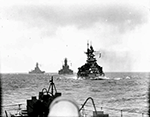 |
370k | HMS Malaya with South Dakota (BB-57) and Alabama (BB-60) following astern in May, 1943. The three ships are astern of the HMS Anson and are participating in British Home Fleet exercises. | Source: Imperial War Museum Admiralty Official Collection, by Mason, H.A. (Lt), Photo No. © IWM (A 16981) via Mike Green. | |
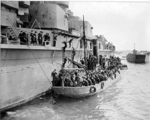 |
389k | South Dakota's (BB-57) crew coming or going while anchored in front of an unknown landing craft (L-152?) off Scapa Flow, 1943. | USN photo courtesy of Pieter Bakels. | |
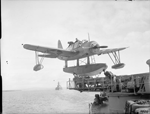 |
368k | The observer entering the Vought-Sikorsky Kingfisher aircraft on board South Dakota (BB-57) before a flight at Scapa Flow while the ship is operating with elements of the Home Fleet. The Kingfisher can operate from their ship while underway and be retrieved by the ship's crane without stopping the ship. The aircraft is mounted on a catapult. | Source: Imperial War Museum Admiralty Official Collection by Hudson F.A. (Lt), Photo No. © IWM (A 17648) via Mike Green. | |
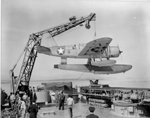 |
290k | View of the view of the observer riding aft of a Vought OS2U Kingfisher aboard the South Dakota (BB-57) while being transferred to the catapult off Scapa Flow, 1943. | USN photo courtesy of Pieter Bakels. | |
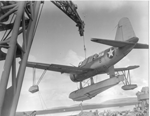 |
228k | Up and away at a slow pace: A Vought OS2U Kingfisher aboard the South Dakota (BB-57) while being transferred to the catapult off Scapa Flow, 1943. | USN photo courtesy of Pieter Bakels. | |
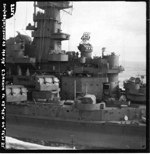 |
697k | The South Dakota (BB-57) taken while underway by a British Coastal Command aircraft operating with the Home Fleet in 1943. Note the officer waving, by the looks of what I can make out from this distance, Captain Mc.Cormick. The different type ready service racks on her 1st. superstructure deck level's bulkheads, probably a left over from an earlier refit at Pearl Harbor in 1942.(see close up aboard a cruiser) Also note the "SN", lightweight portable radar set by General Electric, for emergency use atop #2 turret. The catwalk from her Navigating bridge to a Twin 5-Inch/38 Cal. gun mount. The 20 MM Oerlikon with a MK.14 gun sight on a platform fwd. of this. |
USN photo courtesy of Pieter Bakels. | |
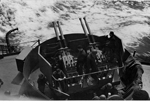 |
5.07k | A pair of 40mm at Scapa Flow. | USN photo # 80-G-53237 & 53238 from NARA, College Park, Maryland, courtesy of Sean Hert. | |
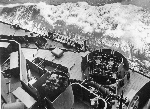 |
202k | Secondary Battery Control aboard the South Dakota (BB-57) in the Atlantic, 1943. Note the Target Bearing Designator Mk.1 Mod.1 at Navigating Bridge Level, removed later and the Mk.51 Director for the below 40mm quadruple mount Mk.2. The Air Defense Station on South Dakota's 011 level was a target information and designation station, which controlled the 5"/38 and machine gun batteries by means of battle telephone circuits to 5"directors and plotting room and to machine gun sector officers. From that station, the Air Defense Officer and Machine Gun Officer designated targets, coached batteries on targets and ordered commence and cease fire in accordance with the doctrine and orders from Conn and Control. Personnel manning the station at general quarters included: Air Defense Officer, Machine Gun Officer, Lookout Officer, Lookout P.O., JS talker and plotter, JA talker, JL talker, 5JP talker & 12 lookouts. The duties of each are apparent from the names of the positions. In condition watches, the same positions were manned minus the Machine Gun Officer. The information needed in controlling the batteries was obtained from target observation by controlling officers, from reports by sky lookouts personnel using designators and binoculars, from use of remote radar PPI and director train indicators and from telephoned reports and orders from Conn, Control and CIC. The CIC information was also passed directly to 5"directors via the 5JP circuit and was plotted in Air Defense on a true relative plotting board by the JS talker. Other instruments, such as ship's course indicator, radio telephone and 20, 21MC communications were seldom used. The Air Defense Station (Aft) was manned only when smoke or damage prevented use of the forward station and the auxiliary station at Batt II. The after station was provided with telephone circuits, director train indicators and the ship's course indicator. The Target Designator Transmitter and Receiver Mk.1 Mod.1 was used primarily to obtain and transmit relative target bearing and elevation of air targets to dual purpose gun directors (Mk.37). It could also be similarly employed for surface targets, but transmitted relative bearing only in that application. The Mk.1 Mod.1 Target Designator Mk.1 had two hand inputs, one electrical input and two electrical outputs. Note the illumination supply snap switch on the fixed pedestal. Rotation of the case around the stationary gear introduced train into the 1-speed generator. Note the cut cable to the contact maker which, when closed, energized a buzzer in the selected receiving station. | USN photo 80-G-52494 courtesy of Pieter Bakels. Text Operation and description of ordnance Installation, South Dakota, August 1944. Photo i.d. courtesy of Tracy White @ Researcher @ Large. | |
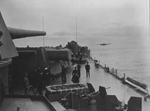 |
218k | Mock attack by RAF Beaufighter making a low-level run during anti-aircraft gunnery drills while operating with the British Fleet near Scapa Flow, 24 June 1943. | NARA photo 80-G-52496 courtesy of Tracy White @ Researcher @ Large. | |
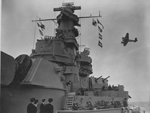 |
206k | Mock attack by RAF Beaufighter making a low-level run during anti-aircraft gunnery drills while operating with the British Fleet near Scapa Flow, 24 June 1943. | NARA photo 80-G-52497 courtesy of Tracy White @ Researcher @ Large. | |
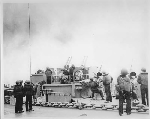 |
194k | Target Practice while underway in the Atlantic, 24 June 1943. | USN photo 80-G-52400 courtesy of Pieter Bakels. Photo i.d. courtesy of Tracy White @ Researcher @ Large. |
|
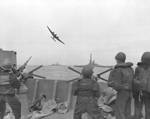 |
414k | Image taken while underway with Alabama (BB-60) and HMS Duke of York. Note the British Coastal Command twin-engined Bomber (a Handley Page 52 Hampden) during its simulated attack on South Dakota (BB-57) on 24 June 1943. |
USN photo courtesy of Phil Hayes via Pieter Bakels. Hampdens photo courtesy of Hampdens bombing up at RAF Waddington, from The Aviation Art of Frank Wootton Battam Books, 1976. Photo i.d. courtesy of Tracy White @ Researcher @ Large. | |
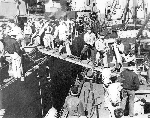 |
213k | Ammunition is taken aboard the South Dakota (BB-57) from another ship at Scapa Flow in 24 June 1943. | USN photo 80-G-52446 courtesy of Pieter Bakels. Photo i.d. courtesy of Tracy White @ Researcher @ Large. | |
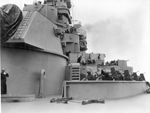 |
451k | 20mm target practice while underway with Alabama (BB-60) and HMS Duke of York. | USN photo 80-G-52402 courtesy of Phil Hayes via Pieter Bakels. Photo i.d. courtesy of Tracy White @ Researcher @ Large. |
|
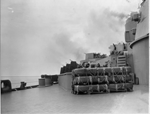 |
382k | 20mm target practice while underway with Alabama (BB-60) and HMS Duke of York. | USN photo 80-G-52401 courtesy of Phil Hayes via Pieter Bakels. Photo i.d. courtesy of Tracy White @ Researcher @ Large. |
|
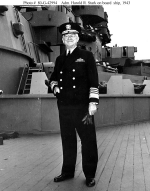 |
90k | Admiral Harold R. Stark, USN, Commander, U.S. Naval Forces in Europe. On board the South Dakota (BB-57) at Scapa Flow, Orkney Islands 26 June 1943. | Official USN photo Naval History and Heritage Command # 80-G-42994, from the collections of the Naval Historical Center. Photo i.d. courtesy of Tracy White @ Researcher @ Large. |
|
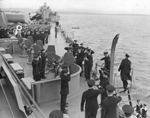 |
458k | Captain Lynde D. McCormick welcomes aboard an unknown Admiral, possibly the First Lord, Mr.A.V.Alexander while at Scapa Flow, July 1943. Note the ship's orchestra and all aboard at attention. | USN photo courtesy of Pieter Bakels. | |
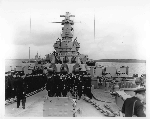 |
269k | The First Lord, Mr.A.V.Alexander on his tour of inspection of the South Dakota (BB-57) at Scapa Flow, July 1943. | USN photo courtesy of Pieter Bakels. | |
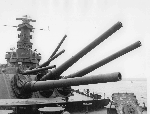 |
270k | The South Dakota (BB-57) at Scapa Flow in 1943. | USN photo courtesy of Pieter Bakels. | |
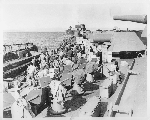 |
277k | The South Dakota (BB-57) replenishing at Scapa Flow from a British ammunition lighter, 21 July 1943. | NARA Photo 80-G-52496 courtesy of Pieter Bakels. Photo i.d. courtesy of Tracy White @ Researcher @ Large. |
|
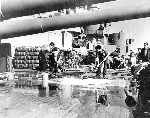 |
256k | Field day aboard South Dakota (BB-57) while at Scapa Flow, 21 July 1943. | USN photo 80-G-52428 courtesy of Pieter Bakels. Photo i.d. courtesy of Tracy White @ Researcher @ Large. |
|
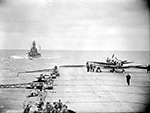 |
418k | HMS Furious (47) preparing to launch Seafire (Sea Spitfire) aircraft for northern convoy protection patrols in July, 1943. The South Dakota (BB-57) is following closely astern. | Source: Imperial War Museum Admiralty Official Collection, by Hampton, J.A. (Lt), Photo No. © IWM(A 17989) © courtesy of Mike Green. | |
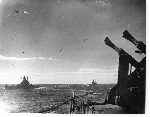 |
242k | The South Dakota (BB-57) in the Atlantic with the British Home Fleet, 1943. | USN photo courtesy of Pieter Bakels. | |
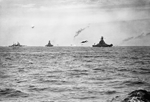 |
584k | Handley Page Hampden torpedo-bombers carry out a realistic attack on British and American battleships during combined exercises. | Photo courtesy of Pieter Bakels. | |
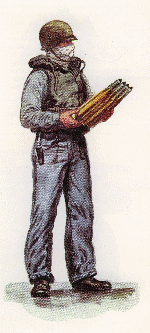 |
350k | 40mm anti - aircraft gunner in combat clothing in 1944, wearing an olive drab steel helmet (some were Navy-Grey), stenciled "G" for gunner over a flash mask with a bulky, kapok-filled jacket worn over a standard working denim shirt and slacks with laced leather shoes. He carries a clip of 40MM shells. | USN photo courtesy of Pieter Bakels. | |
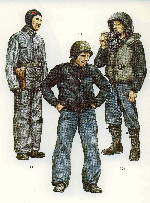 |
380k | From left to right - boatswain, 1942, sailor, 1943 and sailor 1st. class, 1945, wearing a Talker Mk.2 helmet, life jacket over a water- resistant jacket, denim slacks and brown laced leather arctics. | USN photo courtesy of Pieter Bakels. | |
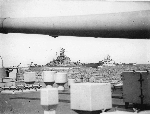 | 677k | South Dakota (BB-57) underway with Alabama (BB-60) as viewed from H.M.S. King George V. In July 1943 Alabama participated in Operation Governor, a diversion aimed toward southern Norway, to draw German attention away from the real Allied thrust, toward Sicily. It had also been devised to attempt to lure out the German battleship Tirpitz, the sister ship of the famed, but short-lived, Bismarck, but the Germans did not rise to the challenge, and the enemy battleship remained in her Norwegian lair. | USN photo courtesy of Pieter Bakels. Text courtesy of DANFS. |
|
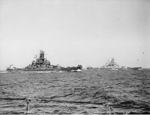 | 1.07k | The South Dakota (BB-57) & Alabama (BB-60) during combined operations in the Northern Atlantic in 1943. Note the "FC" (Mk.3) Main battery Fire Control radar atop her Fire Control tower (Spot 3) for ranging and training purposes and on the MK.38 Director on her Foretop (Spot 1). The height of this armored director above the designed waterline is 117 feet, 7.5/16 inches. That of Spot 2, located just aft of the Stack, 63 feet, 7.5/16 inches. This gave Director #1 a horizon of about 24,000 yards and director #2 a horizon of about 18,000 yards. Note that Director #2 has received the (then) new microwave radar MK.8. with the radar operator's station with Mod.1 equipment in Gun Director MK 38) seen here. The large stove pipes at the ends of her yards are IFF antennas and inboard of them anemometers and weather-vanes. (weather effects on fire control). Atop the Foremast radar platform SC-2, an air search radar with a 15ft x 4ft 6in reflector using a 6x2 array of dipoles. SC-2 incorporated a PPI. One "SG" Surface search radar is fitted atop the Mainmast, the other Fwd.of her Air Defense Level. South Dakota had an extra Conning Tower level to fit her for duty as Flagship. Weight compensation included the elimination of two 5-Inch Twin Mounts. A quadruple 40mm mount such as fitted atop her three near-sister's #2 16-Inch turret would block the view of the lower vision slits. South Dakota therefore received an extra quadruple 40mm mount Mk.2 on both sides of her stack. (Pictured here is Antenna Mount MK.25 Mod.O, installed on the quadruple 40mm mount MK.4.. (Pictured here is an image of Antenna Mount MK.25 Mod.O with radar Mk.34(taken aboard a Canadian destroyer, HMCS Haida. | Scanned from Naval ordnance and Gunnery,1944, NavPers 16116. PDF courtesy of Pieter Bakels. | |
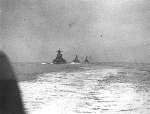 | 379k | Form Line of Battle!!! - The South Dakota (BB-57), Alabama (BB-60) and H.M.S. Anson sail in line ahead during combined operations in the Northern Atlantic in 1943. | USN photo courtesy of Pieter Bakels. | |
| August 1943 /Second Refit & Return to the Pacific |
||||
 |
1.10k | Operating off the U.S. east coast, 9 August 1943, with a destroyer keeping company in the background. Crippen, Craig wrote: 20 November 1942, Noumea, New Caledonia: "From ComServPac X Proceed to Brooklyn Navy Yard X Report to ComDist 14 for further disposition." We couldn't believe our good fortune. It was Christmas, Fourth of July, and New Year's all roiled into one. We transited the Panama Canal, arriving New York 20 December 1942. Two days before Christmas I was sitting home watching our local basketball game. A strange feeling. Like the war never existed in the Midwest. Upon return to Brooklyn, the ship was in drydock with hundreds of welders, repairing the damage from the 49 major caliber shell hits we took at Guadalcanal. 823,000 man hours were required. March, 1943: A year has passed since the ship was commissioned. The whirling campaigns in the Solomons islands were behind us. Overhaul in Brooklyn Navy Yard completed. We got orders to Portland, Maine. Arrived there in a thick fog, the signal men could make out a huge ship- it's the new battleship Alabama , last of the South Dakota class (BB-57 - 60) . Both ships took a few days de-gausing; long electrical lines passed around and under the ships to offset German magnetic mines. Radm. Hustvedt broke his flag on the South Dakota. Our orders were to proceed to Argentia, Newfoundland to await further orders. Argentia was a bleak place, cold and wet. We got a few liberties, but it was only to the fleet landing place. We finally got new orders for Iceland, where we sat swinging around the hook. Didn't know why, but we got a hurry-up order to paint the entire ship within 24 hours, an all hands evolution. Underway. The two battleships with a division of destroyers, course 130 degrees. That heading would take us toward Africa, but it was only a diversion. After a couple of days we steadied up on course 025 degrees. We were now told our destination was Scapa Flow in Northern Scotland. Anchorage of the British Home Fleet. When we arrived, we passed many of their ships at anchor with thousands of British sailors gawking. "The bloomin' Yanks are there!" We would use the British flag and pennant system; therefore, half the gang boarded British ships. We got some of their signal men. Another third class and I were destined for the "KG5," the battleship H.M.S. King George the Fifth. After getting squared away in our new billet, it turned out to be not too bad. The chow was lousy, but at times, so was ours. I was reminded, "Look here, Yank, we've been at this since 1939!" One new thing for us: we were allowed a ration of grog, which, after a couple of tries, I passed. The main staple drink, of course, was tea. Promptly at 1600 they broke out the teapots. I thought that they would break off an engagement with the enemy if it overlapped tea time! The only altercation I saw was actually funny. We were in a huge hall- maybe 500 or 600 servicemen- everyone promoting good fellowship and singing, "Bless them all; bless them all; the long the short and the tall. There will be no promotion this side of the ocean, so cheer up me lads; bless them all." Anyway, one of our guys got tired of his neighbor spouting off about the king. "To hell with the king!" A hushed silence fell over those within earshot. the limey rose off his stool and, in clipped British accent, "Well, to hell with your bloody Babe Ruth then!" We sailed past Bear island and Spitbergen, hoping to stir something up. It was strange to come up on watch at midnight and read the plan of the day in bright sunshine. Anchored back in Scapa Flow, we transferred back to our ship. we left Scotland for Norfolk, Virginia, arriving about 1 August 1943. |
USN photo courtesy of Pieter Bakels. | |
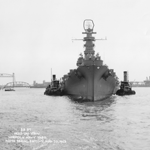 |
2.61k | Bow view at the Norfolk Navy Yard, after her 2nd refit at Norfolk, VA. 20 August 1943. | USN photo # 5872-43 courtesy of Pieter Bakels. | |
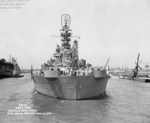 |
4.30k | Stern view of South Dakota (BB-57) at the Norfolk Navy Yard, 20 August 1943. | USN photo # 5876 (43) courtesy of Pieter Bakels. | |
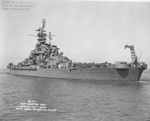 |
356k | Port side view looking fwd after her 2nd refit at Norfolk, VA. August 1943. | Official USN photo # 5875-43, courtesy of David Buell. | |
 |
141k | Off the Norfolk Navy Yard, Virginia, 20 August 1943. | USN photo courtesy of Pieter Bakels. | |
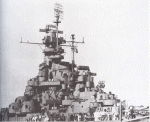 |
109k | South Dakota (BB-57) is shown here after a second 1943 refit at Norfolk, in which a large SK antenna replaced the small SC-2 on her foremast. Note the small SG surface-search antenna on the secondary battery control platform under her forward main battery director. (Detail photograph courtesy of R.F. Summrall). | Photo & text courtesy of U.S. Battleships: An Illustrated Design History by Norman Friedman. | |
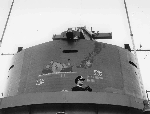 |
74k | Joseph Davis Sandling, Lt.Jg, is the person shown in this photo in the conning tower of the South Dakota (BB-57). He was the youngest chief in the Navy in 1938, before wartime upgrades were happening, and if one looks closely at the hat it shows the crossed anchors instead of the shield. Surface and aerial victory marks painted on the conning tower. Note the direct vision slots in the thick armor, circa 1942/1943. Note her large spotting glass of which the ends can be seen on both sides. Above that the Mk.38 Main Battery Director with atop (still) Mk.3 Main Battery Fire Control radar. On both yards, anemometers and, hardly visible here, "TBS" (Talk Between Ships- VHF band / 72.5MHz) on her starboard yard, a much needed piece of equipment in the Atlantic that allowed the ship to communicate without fear of being overheard by listeners beyond the horizon. Mounted on her Navigating Bridge Level, two whip-antennas, quarter-wave, free standing rigid aerials mounted vertically with one end grounded to to the ship's structure,(the catwalk's splinter-shield), replacing long single-wire aerials. |
Partial text courtesy of Joe Sandling II & Pieter Bakels. USN photo courtesy of Pieter Bakels. |
|
| September 1943 - August 1944 / War in the Pacific - Refit at Puget Sound |
||||
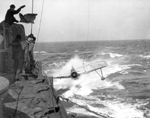 |
171k | 29 September 1943: A Vought OS2U Kingfisher being recovered by South Dakota (BB-57). | USN photo courtesy of Pieter Bakels. | |
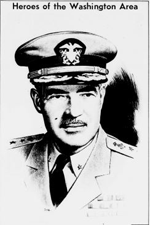 015757g | NR | REAR ADMIRAL THOMAS L. GATCH Hero of two great battles of the Southwest Pacific, in which as a captain he commanded one of the Navy's newest battleships, Rear Admiral Gatch has been awarded the Navy Cross and Gold Star for the two actions which now are a celebrated chapter of American naval tradition. Recovered from wounds received in those critical engagements of last fall which cost the Japanese so heavily in ships and planes, the naval hero became a rear admiral recently upon assuming the post here of Judge Advocate General of the Navy. The Navy Cross was awarded Rear Admiral Gatch for the brilliant achievement of his as yet unidentified battleship in shooting down 32 enemy dive bombers and torpedo planes in the battle of Santa Cruz Islands on 26 October 1942 In the one bomb hit scored on his ship near the end of the attack, Rear Admiral Gatch received wounds which forced him to relinquish command. Although still partially disabled from his wounds, Rear Admiral Gatch less than three weeks later had returned to his battleship command in the great battle off Savo Island on the night of 14-15 November. It was in this battle that the Japs' boldest attempt to overwhelm Guadalcanal was smashed by American forces. In the second citation awarding him the Gold Star in lieu of a second Navy Cross, Rear Admiral Gatch's ship is credited in this action with "sinking ot least one Japanese cruiser and assisting in the destruction and damage of other enemy vessels." The award cites his "calm coolness in the face of great danger and inspiring leadership" as contributing to his ship's "high combat efficiency." Rear Admiral Gatch makes his home here with Mrs. Gatch at 3103 Macomb street N.W. He was an earlier resident of Washington during tours of duty on the staff of the Judge Advocate General, after taking his law degree from George Washington University. He was assistant judge advocate general when assigned to command of a battleship in February, 1942. This is one of a series of drawings of decorated war heroes by Newman Sudduth of the Evening Star's art staff. | A .P. Photo Image and text provided by Library of Congress, Washington, DC. Photo & text by Evening Star. [volume] (Washington, D.C.) 1854-1972, 03 October 1943, Image 90, via chroniclingamerica.loc.gov. | |
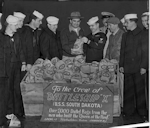 |
129k | Ditty bags given to the crew members of South Dakota (BB-57), 27 October 1943. | George D. McDowell Philadelphia Evening Bulletin Photographs @ digital.library.temple.edu courtesy of Mike Green. | |
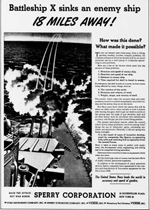 015708a | NR | Battleship X sinks an enemy ship
18 MILES AWAY ! How was this done? What made it possible? To hit an enemy ship miles away, from a rolling, pitching warship, involves complex problems, the complete answers to which are known only by our naval personnel and by a small group of companies specializing in such problems. Here are a few of the factors which enter into the solution of these problems: 1. Direction and speed of enemy ship. 2. Direction and speed of our ship. 3. Distance to enemy ship. 4. Time required for shell to travel to enemy. Furthermore, the shell travels in a curve, its true course being affected by many things, such as: 5. The rotation of the earth. 6. Direction and velocity of wind. 7. Weight, shape, and velocity of shell. The answer, which takes into account these and other problems, must be available immediately, since both our ship and the enemy ship are on the move. Our Navy must know where the enemy ship will be when our shells arrive, many seconds or even a minute after leaving the guns. And to get our shells to arrive at this precise spot, the angle of gun elevation, lead, and all other factors must be calculated with unbelievable accuracy, and the gun put into correct firing position. The present mechanical marvel, called fire control, which solves these problems, involves among other things the use of hydraulics, optics, calculating machines, and electronics. Naturally, it did not spring into being overnight. It is the result of years of inventive development by companies like Sperry, co-operating fully with and receiving full co-operation from the Armed Forces. Since it takes so many years to perfect such equipment the development work, engineering, and testing had to be completed during peacetime. Otherwise there would have been no equipment ready when war came. All this took large sums of money and the best efforts of highly trained, specialized engineers. In addition to the development of many peacetime devices, Sperry companies have specialized in the creation and manufacture of fire-control equipment for the Navy since 1908. The United States Navy leads the world in accuracy and speed of gunfire. BACK THE ATTACK BUY WAR BONDS SPERRY CORPORATION 30 ROCKEFELLER PLAZA. NEW YORK 20 FORD INSTRUMENT COMPANY. INC. \ SPERRY GYROSCOPE COMPANY. INC. VlCKERS, INC. \ Waierbury Tool Division, VlCKERS, INC. | Image and text provided by Library of Congress, Washington, DC. Photo & text by Evening Star. [volume] (Washington, D.C.) 1854-1972, 25 October 1943, Image 16, via chroniclingamerica.loc.gov. | |
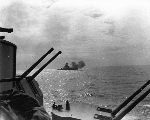 |
466k | The Alabama (BB-60) firing as viewed from the South Dakota (BB-57) on 29 October 1943. Note South Dakota's 5-Inch battery in the foreground. | USN photo courtesy of Pieter Bakels. | |
 |
209k | The battleships South Dakota (BB-57), Alabama (BB-60) and North Carolina (BB-55) as seen from the Essex class carrier Intrepid CV-11 on 25 January, 1944. | USN photo courtesy of Pieter Bakels. | |
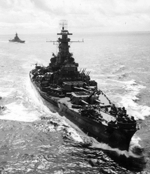 |
423k | South Dakota (BB-57) followed by Alabama (BB-60) on their way to the Marshalls to shell Roi and Namur islands on 1 February 1944. | USN photo submitted by Pieter Bakels. | |
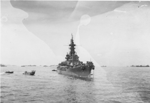 |
581k | The South Dakota (BB-57) taken by an unnamed veteran of US Navy LCI-981 during the landings at Hollandia in April 1944. | USN photo courtesy of Pieter Bakels. | |
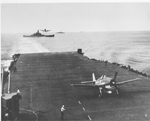 |
258k | South Dakota (BB-57) crosses the stern of the Lexington (CV-16) on 28 April 1944. A F6F-3 Hellcat of VF-16 is being recovered on the Lexington. | US Navy and Marine Corps Museum/Naval Aviation Museum, Photo No.1996.253.7180.014. via Mike Green. | |
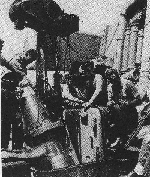 |
321k | 16-inch Projectile loading. | USN photo submitted by Pieter Bakels. | |
 |
55k | Boxing team training in 1944 on South Dakota's (BB-57) fantail. | USN photo submitted by Pieter Bakels. | |
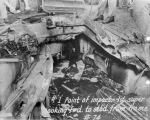 |
80k | Various scenes of destruction are shown here and in the next 4 photos following a bomb hit on the South Dakota (BB-57) on the 01 deck by a 500-pound bomb dropped from a Japanese plane at about 1049 on the morning of 19 June 1944. The bomb hit the main deck where it blew a large hole, cut wiring and piping, but inflicted no other serious material damage. However, personnel losses were heavy: 24 killed and 27 wounded. Pictured here is the point of impact, looking forward to starboard from frame # 74. |
Photo courtesy of Tracy White @ Researcher @ Large. | |
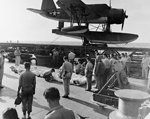 |
1.10k | One guy to far right looks like dad since his damage control repair party near that 40mm on port side were all killed. The number of bodies would be right with the number killed 19 June 1944. It appeared that the picture had a July 1944 date, so I think it was really 20 June 1944. Dad mentioned that it was so hot on board that the dead usually had to be buried at sea almost immediately. My father's battle station was below in the main damage control and it was his turn to go topside and report when the bomb hit. He told me that he went out the forward hatch on the starboard side. he had to open and close behind him watertight doors on the way up. Right before he went to that last hatch that opened to the main deck he heard the bomb hit, and said it sounded muffled and like a great big bag of sand being dropped (probably shrapnel hitting everywhere) and as he went to the area on the portside and saw bodies and parts all over, and one guy hanging over the tub of the 40mm upside down with blood gushing out of his helmet. The damage control party near the hit were all killed, and the other damage control parties were on the scene already. |
USN photo courtesy of Joseph Sandling via Pieter Bakels. | |
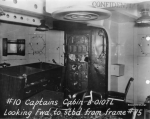 |
52k | Damage to the Captain's cabin, looking forward from starboard from frame # 75. | Photo courtesy of Tracy White @ Researcher @ Large. | |
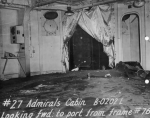 |
64k | Damage to the Admiral's cabin, looking forward to port from frame # 76. | Photo courtesy of Tracy White @ Researcher @ Large. | |
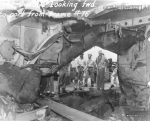 |
65k | Looking forward to port from frame # 76. | Photo courtesy of Tracy White @ Researcher @ Large. | |
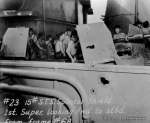 |
45k | Damage to the splinter shields of a 20mm gun, looking forward to starboard. | Photo courtesy of Tracy White @ Researcher @ Large. | |
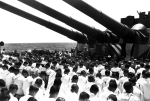 |
464k | The crew of the South Dakota (BB-57) stands with bowed heads, while Chaplain N.D. Lindner reads the benediction held in honor of fellow shipmates killed in the air action of Guam on 19 June 1944. | NARA FILE #: 026-G-4677. USN photo # HD-SN-99-02591 from the Defense Visual Information Center, courtesy of dodmedia.osd.mil. | |
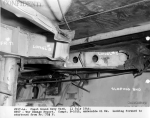 |
65k | Underside of the main deck. The temporary patch installed over the hole appears here, looking forward to starboard from frame # 72.5 at Puget Sound Navy Yard on 11 July 1944. | Photo courtesy of Tracy White @ Researcher @ Large. | |
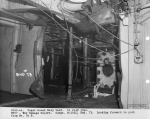 |
58k | Damage to the South Dakota (BB-57) as she appeared at Puget Sound Navy Yard on 11 July 1944. Looking forward to port from frame # 76. | Photo courtesy of Tracy White @ Researcher @ Large. | |
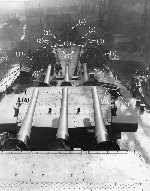 |
367k | View looking fwd after a refit at Puget Sound Navy Yard on 11 July 1944. | USN photo courtesy of Pieter Bakels. | |
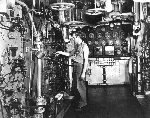 |
144k | Engineering Spaces aboard the South Dakota (BB-57). | USN photo courtesy of Pieter Bakels. | |
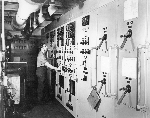 |
169k | Engineering Spaces aboard the South Dakota (BB-57). | USN photo courtesy of Pieter Bakels. | |
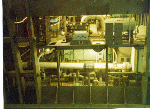 |
288k | Model of the South Dakota (BB-57) engineering spaces. | USN photo courtesy of Pieter Bakels. | |
 |
53k | Model of the South Dakota (BB-57) engineering spaces. | USN photo courtesy of Pieter Bakels. | |
 |
35k | Model of the South Dakota (BB-57) engineering spaces. | USN photo courtesy of Pieter Bakels. | |
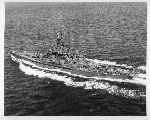 |
356k | Puget Sound Navy Yard photo of the South Dakota (BB-57) as seen in Puget Sound on 21 August 1944 after refit. The photo is taken off the port beam and shows her at 19 knots speed. | USN photo courtesy of Pieter Bakels. | |
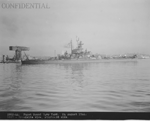 |
377k | Starboard broadside view of the South Dakota (BB-57) as seen in Puget Sound on 21 August 1944 after refit. | USN photo # 2862-44, courtesy of David Buell. | |
 |
294k | Portside view of the South Dakota (BB-57) as seen in Puget Sound on 21 August 1944 after refit. | USN photo courtesy of Pieter Bakels. | |
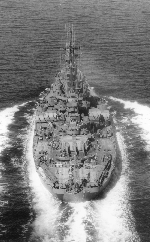 |
417k | Stern view of the South Dakota (BB-57) as seen in Puget Sound on 21 August 1944 after refit. | USN photo courtesy of Pieter Bakels. | |
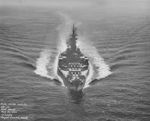 |
896k | Bow view while underway in Puget Sound after her refit, 21 August 1944. | USN photo courtesy of David Buell. | |
| September 1944 - September 1945 / Victory in the Pacific |
||||
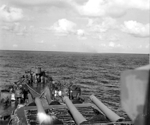 015725 |
375k | The view forward aboard South Dakota (BB-57) while operating in TG38.4 off the Philippines, 29,30, or 31 October 1944. Photo by S.Zalkind, PhoM1c. | Photo courtesy of John Chiquoine and Mitch Zalkind. | |
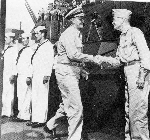 |
65k | Admiral Nimitz coming aboard the South Dakota (BB-57), greeted by Bull Halsey. | Courtesy of Pieter Bakels. | |
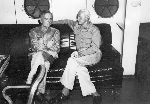 |
33k | Admiral Chester Nimitz and Admiral Halsey aboard South Dakota (BB-57), 1944. | Courtesy of Pieter Bakels. | |
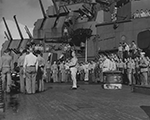 |
291k | Burial at sea of Seaman Second Class Joseph Cavaliere, a gunner killed on 5 November 1944 while operating east of the Philippines in support of carrier air strikes. Cavaliere was killed and seven others wounded by fragments of shells from other US ships firing at attacking Japanese aircraft. | USN photo # 80-G-345631, now in the collection of the US National Archives in College Park, Maryland, courtesy of Tracy White @ Researcher @ Large. | |
 |
361k | The Essex (CV-9) takes a hit as seen by the South Dakota (BB-57). On 25 November 1944, for the first time in her far-ranging operations and destruction to the enemy, Essex received injury. A kamikaze hit the port edge of her flight deck landing among planes gassed for takeoff, causing extensive damage, killing 15, and wounding 44. As seen from the Essex on 25 November 1944, a kamikaze is splashed off of the port side of the South Dakota. |
USN photo courtesy of Pieter Bakels. Text courtesy of DANFS. Insert photo courtesy of US Navy and Marine Corps Museum/Naval Aviation Museum, Photo No. 1983.046.010.086 via Mike Green. | |
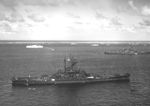 |
205k | On 19 June 1944 the battleship was again operating with the fast carriers. It was known that a major Japanese force was approaching from the west, and the American capital ships were placed so that they could continue to support the ground forces on Saipan and also intercept this enemy force. At 1012, a large group of bogies was reported coming in from the west. At 1049, a "Judy" dropped a 500-pound bomb on South Dakota's (BB-57) main deck where it blew a large hole, cut wiring and piping, but inflicted no other serious material damage. However, personnel losses were heavy: 24 killed and 27 wounded. The ship continued to fight throughout the day as air attacks were continuous. This was the first day of the Battle of the Philippine Sea and was called the "Marianas Turkey Shoot" as the Japanese lost over 300 aircraft. The air battle continued throughout the 20th. When it ended, the badly mauled Japanese fleet no longer posed a threat to the American conquest of the Marianas. The task group returned to Ulithi on 27 June, and South Dakota sailed via Pearl Harbor to the west coast, arriving at Puget Sound on 10 July. The battleship was overhauled at the navy yard there; and, after sea trials, sailed on 26 August for Pearl Harbor. South Dakota was routed to Ulithi and, upon her arrival, was attached to TG 38.3; one of four task groups of formed Task Force 38, the Fast Carrier Task Force. She appears here at anchor, at Ulithi Atoll, 8 December 1944. The hospital ship in the background is the Samaritan (AH-10). The battleship New Jersey (BB-62) appears off the South Dakota's port bow. |
National Archives photo # 80G-294133 courtesy of David Buell. Text courtesy of DANFS. Photo i.d. courtesy of David C. Nilsen, CTR USA, TRADOC. |
|
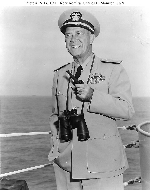 |
33k | Captain Momsen was commanding officer of the battleship South Dakota (BB-57) in December 1944 - July 1945. He appears here as an Rear Admiral on board ship, circa the later 1940s or the 1950s. | U.S. Naval Historical Center Photograph # NH 65031. Donation of Mrs. Charles B. Momsen. Photo submitted by Bill Gonyo. | |
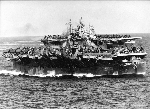 |
570k | TG 38.3 beginning to reform a column formation after making a simultaneous turn to port. The ships are entering Ulithi Anchorage on 12 December 1944 after strikes against the Japanese in the Philippines. Ships visible in this photo are: Langley (CVL-27); Ticonderoga (CV-14); Washington (BB-56); North Carolina (BB-55); South Dakota (BB-57); Santa Fe (CL-60); Biloxi (CL-80); Mobile (CL-63) and Oakland (CL-95). | None of these can be 12 December. These ships (TG 38.3) departed Ulithi on 11 December. This TG entered Ulithi together on 2 and 24 December. These are likely 24 December 1944 when they're conducting numerous maneuvers and firing exercises while entering Ulithi. Slight chance 2 December but if Oakland (CL-95) is in the picture, she didn't enter with the others on 2 December. One thing for certain, these are not the 11th like the caption on NHHC states. Many open discussions on forums discussing the merits of both dates. Text & ID courtesy of Richard Averitt. USN photo courtesy of Pieter Bakels. |
|
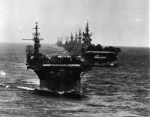 |
455k | TG 38.3 enters Ulithi anchorage in column, 12 December 1944 while returning from strikes on targets in the Philippines. Ships are (from front): Langley (CVL-27); Ticonderoga (CV-14); Washington (BB-56); North Carolina (BB-55); South Dakota (BB-57); Santa Fe (CL-60); Biloxi (CL-80); Mobile (CL-63) and Oakland (CL-95). | None of these can be 12 December. These ships (TG 38.3) departed Ulithi on 11 December. This TG entered Ulithi together on 2 and 24 December. These are likely 24 December 1944 when they're conducting numerous maneuvers and firing exercises while entering Ulithi. Slight chance 2 December but if Oakland (CL-95) is in the picture, she didn't enter with the others on 2 December. One thing for certain, these are not the 11th like the caption on NHHC states. Many open discussions on forums discussing the merits of both dates. Text & ID courtesy of Richard Averitt. Official USN photo # 80-G-301351 & HN-SD-97-00850 now in the collections of the National Archives. Photo from the Department of Defense Still Media Collection, courtesy of dodmedia.osd.mil. | |
 | 1.20k | TG 38.3 enters Ulithi anchorage in column, 12 December 1944 while returning from strikes on targets in the Philippines. Ships are (from front): Ticonderoga (CV-14); Washington (BB-56); North Carolina (BB-55); South Dakota (BB-57); Santa Fe (CL-60). | None of these can be 12 December. These ships (TG 38.3) departed Ulithi on 11 December. This TG entered Ulithi together on 2 and 24 December. These are likely 24 December 1944 when they're conducting numerous maneuvers and firing exercises while entering Ulithi. Slight chance 2 December but if Oakland (CL-95) is in the picture, she didn't enter with the others on 2 December. One thing for certain, these are not the 11th like the caption on NHHC states. Many open discussions on forums discussing the merits of both dates. Text & ID courtesy of Richard Averitt. USN photo courtesy of Pieter Bakels. |
|
 |
575k | TG 38.3 entering Ulithi on 12 December 1944, taken by Essex (CV-9), & showing the Ticonderoga (CV-14); Washington (BB-56); North Carolina (BB-55); and South Dakota (BB-57). | Text & ID courtesy of Richard Averitt. None of these can be 12 December. These ships (TG 38.3) departed Ulithi on 11 December. This TG entered Ulithi together on 2 and 24 December. These are likely 24 December 1944 when they're conducting numerous maneuvers and firing exercises while entering Ulithi. Slight chance 2 December but if Oakland (CL-95) is in the picture, she didn't enter with the others on 2 December. One thing for certain, these are not the 11th like the caption on NHHC states. Many open discussions on forums discussing the merits of both dates. Text & ID courtesy of Richard Averitt. USN photo courtesy of Pieter Bakels. |
|
 |
88k | Battleships of the U.S Pacific Fleet following Ticonderoga (CV-14) [out of photo ahead of the Washington (BB-56)] entering Ulithi Atoll on 12 December 1944. Washington, North Carolina (BB-55), and South Dakota (BB-57) are in line ahead formation. Note that three camouflage schemes are shown; MS22 (Washington ), MS32/18d (North Carolina ) and MS21 (South Dakota ). | None of these can be 12 December. These ships (TG 38.3) departed Ulithi on 11 December. This TG entered Ulithi together on 2 and 24 December. These are likely 24 December 1944 when they're conducting numerous maneuvers and firing exercises while entering Ulithi. Slight chance 2 December but if Oakland (CL-95) is in the picture, she didn't enter with the others on 2 December. One thing for certain, these are not the 11th like the caption on NHHC states. Many open discussions on forums discussing the merits of both dates. Text & ID courtesy of Richard Averitt. Naval Historical Photo # 80-G-301950 submitted by Mike Green. |
 |
88k | Battleships of the U.S Pacific Fleet following Ticonderoga (CV-14) [out of photo ahead of the Washington (BB-56)] entering Ulithi Atoll on 12 December 1944. Washington, North Carolina (BB-55), and South Dakota (BB-57) are in line ahead formation. Note that three camouflage schemes are shown; MS22 (Washington), MS32/18d (North Carolina) and MS21 (South Dakota). | Naval Historical Photo #80-G-301950 submitted by Mike Green. |  |
258k | 17 December 1944, Typhoon Cobra - taken from the superstructure when 25-foot waves were coming over the #2 turret. | USN photo courtesy of Pieter Bakels. |
 |
132k | Starboard and overhead line art drawing by A.L. Raven shows the South Dakota (BB-57) in 1945. | Photo & text courtesy of U.S. Battleships: An Illustrated Design History by Norman Friedman. | |
 |
431k | The South Dakota (BB-57) operated with the fast carriers in their strikes against the Tokyo area on 17 February 1945 and against Iwo Jima on the 19th and 20th in support of amphibious landings there. Tokyo again was the target on the 25th, and Okinawa's turn came on 1 March. After rearming at Ulithi, the task groups sailed toward Japan again and pounded targets in the Kobe, Kure, and Kyushu areas on 18 and 19 March. | Text courtesy of DANFS. USN photo courtesy of Pieter Bakels. | |
 |
78k | Steaming into heavy seas on 24 February 1945, while en route to take part Task Force 58's second Tokyo raid of the month. Photographed from atop the battleship's forward fire control platform. Spray is enveloping the forecastle 40mm gun mounts in weather that curtailed the number of strikes flown on 25 February and forced the cancellation of those planned for the 26th. | Official USN photo Naval History and Heritage Command # 80-G-K-3345, now in the collections of the National Archives. | |
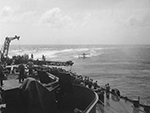 |
118k | Vought OS2U Kingfisher taxiing up after landing in the smooth water created by a gradual turn to port by South Dakota (BB-57) | USN # 80-G-303954 now in the collection of the US National Archives in College Park, Maryland, courtesy of Tracy White @ Researcher @ Large. | |
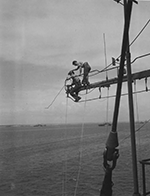 |
154k | Two enlisted men welding on yardarm of South Dakota (BB-57), February 1945. | USN # 80-G-303947 now in the collection of the US National Archives in College Park, Maryland, courtesy of Tracy White @ Researcher @ Large. | |
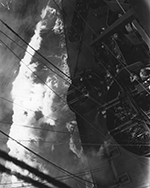 |
162k | Port side quad 40mm mounts filling their tubs with spent shells demonstrates the validity of the Navy's concern about these gun mounts jamming in train from prolonged action. | USN # 80-G-303958 now in the collection of the US National Archives in College Park, Maryland, courtesy of Tracy White @ Researcher @ Large. | |
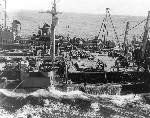 |
542k | The South Dakota (BB-57) receives gas cylinders from the Chikaskia (AO-54) on February 1945. | USN photo courtesy of Pieter Bakels. | |
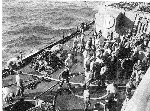 |
184k | Getting the hoses ready for refueling at sea, something that was done several hundred times during her career. | USN photo courtesy of Pieter Bakels. | |
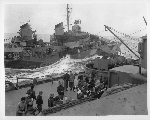 |
221k | South Dakota's (BB-57) band strikes up the hit tune "Ode to a refueling Destroyer,1945." | USN photo courtesy of Pieter Bakels. | |
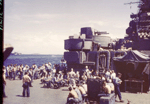 |
403k | Fantail, probably at Ulithi, around March 1945. Note the #3 16-Inch Turret swung to port for the ship's band to perform an informal concert. | USN photo courtesy of Pieter Bakels. | |
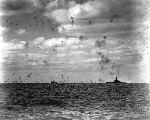 |
409k | Ship's anti-aircraft in action off Southern Honshu, Japan, on 10 March 1945. The battleship South Dakota (BB-57) is in the foreground. | USN photo courtesy of Pieter Bakels. | |
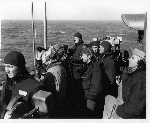 |
52k | Men during an alert aboard South Dakota (BB-57), 28 March 1945. | USN photo courtesy of Pieter Bakels. | |
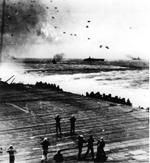 |
692k | South Dakota (BB-57) firing as taken by Essex (CV-9) during the occupation of Okinawa. | USN photo courtesy of Pieter Bakels. | |
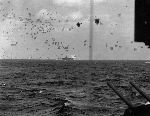 |
333k | Anti-aircraft bursts from TF 58 as Jap plane is hit and explodes just beyond the Essex (CV-9) in action off Okinawa, Ryukyu Islands, on 11 April 1945 as seen from the South Dakota (BB-57). | USN photo courtesy of Pieter Bakels. | |
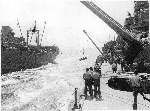 |
118k | Presents from the mainland U.S. arriving via sea for delivery to the Japanese. Taking on 16-inch shells from an ammunition ship. | USN photo courtesy of Pieter Bakels. | |
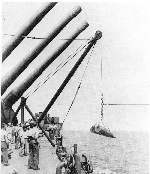 |
95k | Taking on 16-inch shells from an ammunition ship. | USN photo courtesy of Pieter Bakels. | |
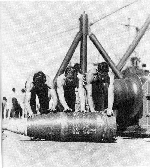 |
127k | Taking on 16-inch shells. | USN photo courtesy of Pieter Bakels. | |
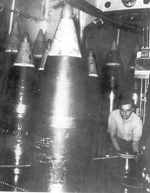 |
723k | 16-Inch Shells being stored aboard South Dakota (BB-57). | Courtesy of Pieter Bakels. | |
 |
250k | A portable crane is used aboard South Dakota (BB-57) to load 16-Inch shells. | Courtesy of Pieter Bakels. | |
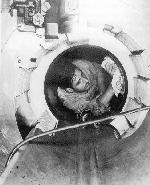 |
44k | A Sailor works inside one of South Dakota's (BB-57) 16-Inch guns. | Courtesy of Pieter Bakels. | |
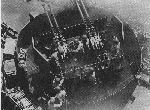 |
125k | Quadruple 40mm mount practice. | USN photo courtesy of Pieter Bakels. | |
 |
205k | While rearming from the ammunition ship Wrangell (AE-12) on 6 May 1945, a tank of 16-inch high capacity powder exploded, causing a fire and exploding four more tanks. Turret No. 2 magazines were flooded and the fires put out. The ship lost three men killed instantly; eight more died of injuries; and 24 others suffered non-fatal wounds. The ship retired to Guam from 11 to 29 May when she sailed for Leyte, arriving on 1 June. This photo was taken on 6 May 1945, 20 minutes following the sixteen-inch powder explosion by turret #3. |
Courtesy of Pieter Bakels. Partial text courtesy of Andrzej Demus. | |
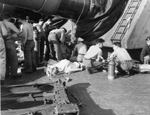 |
2.05k | Administering plasma and other first aid to victims of explosion on board of the South Dakota (BB-57), 6 May 1945. | USN photo courtesy of Pieter Bakels. | |
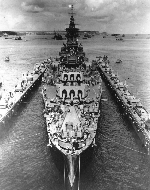 |
265k | The South Dakota (BB-57) is pictured here secured to the handling lines of the floating drydock ABSD-3 on 11 May due to damage sustained after the ammo explosion of 6 May. |
USN photo courtesy of Mauer D. Rell, S1C 8/43-12/46 & Pieter Bakels. Photo i.d. courtesy of Andrzej Demus & Cathy Verschelden. | |
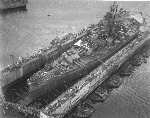 |
426k | The South Dakota (BB-57) in the floating drydock ABSD-3 off Guam after the ammo explosion of 6 May. Atop her Mainmast radar platform is an inclined SC-4 antenna for zenith search and on the portside of it, an AS571/SLR ECM antenna. Directly below on a platform her aft "SG" surface search set. In front and aft of her "SK" radar platform hardly visible here, are two SPT-4 circular plates/disks for the active jamming system operating in the range of 200-550 MHz, derived directly from the APQ-2 airborne jammers, designed for use against night fighters in bombers, are bracketed to the platform. On the fore topmast is a "SG" set with attached P/S, SPR-1/APR-1 antennas, a passive collection system to detect Japanese radars. Fitted P/S of her Fwd. Air Defense are another two, not visible here. Just below, two TDY-1A, newer and more powerful than SPT-4, operating in a higher frequency band and intended as a counter to enemy shipborne fire control radars, were fitted P/S of her Foretop and below that, also P/S, two 2AX-NAN "Nancy" IR beacons (not visible here). Directly below the Fwd. Air Defense Level AS-37 "Wagon Wheel" antennas and a DBM antenna are visible. Atop the Mk.38 Director (spot 1), the Mk.8 Main Battery Fire Control set. Note the 20mm gallery atop her No.2 sixteen inch turret and just eight twin five-inch mounts. The "scoreboard" on her fire control tower (spot 3) has been painted over, much to the annoyance of her crew. Numerous whip antennas for ship-to-ship and ship-to-shore communications can be seen. |
USN photo courtesy of Mauer D. Rell, S1C 8/43-12/46 & Pieter Bakels. Photo i.d. courtesy of Andrzej Demus & Cathy Verschelden. Technical description courtesy of Pieter Bakels. |
|
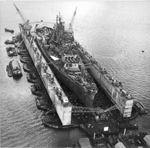 |
510k | Slightly different angle of the South Dakota (BB-57) in the floating drydock ABSD-3 at Guam. | USN photo courtesy of Pieter Bakels. | |
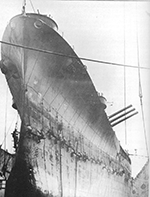 |
1.53k | Crew members of the South Dakota (BB-57) prepare the ship for painting while in drydock. Note the chains suspended from the main deck to the scaffolds. | USN photo courtesy of Pieter Bakels. | |
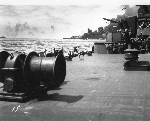 |
304k | The Bunker Hill (CV-17) burning as gas and ammunition explode after being attacked by Japanese suicide divers as seen by the South Dakota (BB-57) on 11 May 1945. | USN photo courtesy of Pieter Bakels. | |
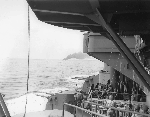 |
285k | Bunker Hill (CV-17) burning after being attacked by Japanese kamikazes, as seen from the South Dakota (BB-57), 11 May 1945. | USN photo courtesy of Pieter Bakels. | |
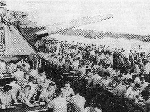 |
220k | Having chow topside-Too hot below. | USN photo courtesy of Pieter Bakels. | |
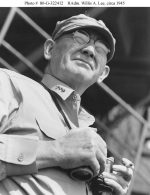 |
66k | Vice Admiral Willis A. Lee, Jr., USN, Commander Battleship Squadron Two. On board South Dakota (BB-57), circa 1945. This photograph was received by the Navy Photographic Science Laboratory on 24 May 1945. |
Official USN photo # 80-G-322412, now in the collections of the National Archives. | |
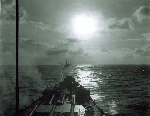 |
269k | The United States battleships Indiana (BB-58), Massachusetts (BB-59) and Alabama (BB-60) form a line ahead during target practice as seen from the South Dakota (BB-57), 1945. | USN photo courtesy of Pieter Bakels. | |
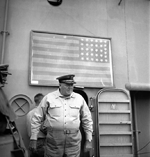 0825729 |
221k | Shafroth was appointed Commander of Task Unit 34.8.1 of the Third Fleet under Admiral William F. Halsey on 14 July 1945 and his command consisted the battleships South Dakota (BB-57), Indiana (BB-58) and Massachusetts (BB-59) as well as the heavy cruisers Quincy (CA-71) and Chicago (CA-136) and nine destroyers. He was tasked to attack the ironworks at Kamaishi in northern Honshu. At the time the city had a population of 40,000 and the ironworks was among the largest in Japan. However, due to shortages of coking coal and other raw materials, the ironworks was running at less than half its capacity. It was the first naval bombardment of mainland Japan during the World War II. US Navy Admiral John F. Shafroth walking past an American flag (mounted in reverse years earlier) aboard the battleship South Dakota (BB-57). Flag was carried by Commodore Matthew Perry on an 1853 trade expedition to Japan; picture taken 2 September 1945 during the official Japanese surrender ceremony ending WWII. |
Photo by John Florea courtesy of life.com | |
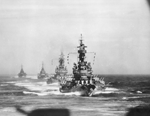 |
3.22k | THIRD FLEET WARSHIPS FORM BATTLE LINE OFF JAPAN. MOVING IN COLUMN, SOME OF THE THIRD FLEET WARSHIPS MANEUVER NEAR KAMAISHI, ON JAPAN'S HOME ISLAND OF HONSHU ON JULY 14. A FEW MINUTES LATER THEY OPENED FIRE ON THE IMPERIAL IRON WORKS AT KAMAISHI. NAVY DID NOT NAME WARSHIPS BUT SAID MASSACHUSETTS (BB-59), SOUTH DAKOTA (BB-57), INDIANA (BB-58), QUINCY (CA-71) AND CHICAGO (CA-136) PARTICIPATED IN THE SHELLING. Bombardment of Kamaishi, Japan, 14 July 1945. Battleships and heavy cruisers steam in column off Kamaishi, at the time they bombarded the iron works there, as seen from South Dakota (BB-57). Indiana (BB-58) is the nearest ship, followed by Massachusetts (BB-59). Cruisers Chicago (CA-136) and Quincy (CA-71) bring up the rear. |
API photo, & text courtesy of Pieter Bakels. Text courtesy of Naval History and Heritage Command # NH 80-G-490143. |
|
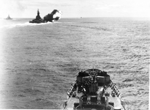 |
1.10k | South Dakota (BB-57) fires a salvo on the city & steel works of Kamaishi, Honshu, Japan, taken by the Chicago (CA-136). | USN photo courtesy of Pieter Bakels. | |
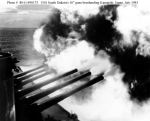 |
64k | Bombardment of Kamaishi, Japan, 14 July 1945. South Dakota (BB-57) fires her forward 16"/45 guns at Kamaishi targets during the bombardment. | Official USN photo Naval History and Heritage Command # 80-G-490175, from the collections of the Naval Historical Center. | |
 |
357k | Indiana (BB-58) fires a salvo from her forward 16"/45 guns at the Kamaishi plant of the Japan Iron Company, 250 miles north of Tokyo. A second before, South Dakota (BB-57), from which this photograph was taken, fired the initial salvo of the first naval gunfire bombardment of the Japanese Home Islands. The superstructure of Massachusetts (BB-59) is visible directly behind Indiana. The heavy cruiser in the left center distance is either Quincy (CA-71) or Chicago (CA-136). | Text courtesy of Naval History and Heritage Command from photo # 80-G-K-6035. PDF & photo courtesy of Pieter Bakels. | |
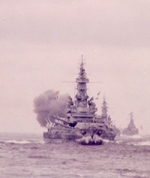 |
251k | The bombardment of Kamaishi as seen from the decks of South Dakota (BB-57). | Photo courtesy of Pieter Bakels. | |
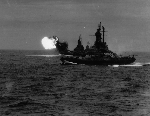 |
419k | The battleships Indiana (BB-58) and Massachusetts (BB-59) operating off Honshu. The Massachusetts is firing. The South Dakota (BB-57) can be seen behind her. | USN photo courtesy of Pieter Bakels. | |
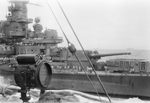 |
687k | At sea off Japan, 1 August 1945: HMAS Norman passing South Dakota (BB-57). Note the two Vought OS2U Kingfisher floatplanes on the stern and the merchant ship-type cowl ventilator between the two catapults. |
USN photo courtesy of Pieter Bakels. | |
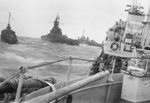 |
390k | At sea off Japan, 30 August 1945: The battleship South Dakota (BB-57) w. the Fletcher class destroyer Healy (DD-572) (Stb.), and the Sumner class DeHaven (DD-727) (port) Tb. HMAS Norman. | USN photo courtesy of Pieter Bakels. | |
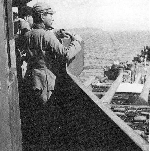 |
116k | Japanese harbor pilot aboard South Dakota (BB-57) entering Tokyo Bay. | USN photo courtesy of Pieter Bakels. | |
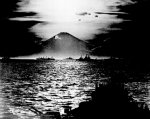 |
569k | Mount Fujiyama, Japan as seen from the South Dakota (BB-57) in Tokyo Bay. August 1945. | NARA FILE #: 080-G-490487. Photo # HD-SN-99-03030 from the Department of Defense Still Media Collection, courtesy of dodmedia.osd.mil. | |
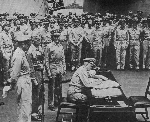 |
231k | The Victors write the Surrender Terms - Note the South Dakota (BB-57) in the background. | USNIP., November 1947. Photo courtesy of Pieter Bakels. | |
| Post WW II - Scrapping |
||||
 |
35k | South Dakota (BB-57) anchored in Sagami Wan, Honshu, on 27 August and entered Tokyo Bay on the 29th. She steamed out of Tokyo Bay on 20 September and proceeded, via Okinawa and Pearl Harbor, to the west coast of the United States. Co. E 3rd. Fleet Marine provisional landing force getting final orders before leaving the South Dakota for landing in Japan. (Hiram Quillin from left, with baseball cap.) |
Courtesy of Pieter Bakels. Partial text courtesy of DANFS. |
|
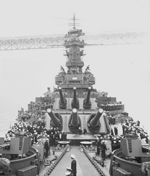 015745n | NR | IN GOLDEN GATE VICTORY PARADE FROM THE BRIDGE OF HIS FLAGSHIP, the South Dakota (BB-57), Admiral William "Bull" Halsey (inset) looks up at Golden Gate Bridge aa the battlewagon leads 13 units of the mighty Third Fleet into San Francisco Bay. Although the day was foggy, thousands of spectators gathered atop the famed span and on shore to welcome the fighting admiral and his battle-seasoned veterans. This photo of the South Dakota was taken as she returned to the USA after war's end. | Photo courtesy of David Buell. International Soundphoto Image and text provided by University of North Carolina at Chapel Hill Library, Chapel Hill, NC. Photo from The Wilmington Morning Star. [volume] (Wilmington, N.C.) 1909-1990, 26 October 1945, Image 15, via chroniclingamerica.loc.gov. | |
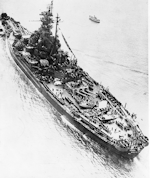 |
849k | South Dakota (BB-57) taken as she entered San Francisco Bay after the end of the war. Note the "homeward bound" pennant. | USN photo courtesy of David Buell. | |
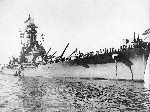 |
167k | The crew of the South Dakota (BB-57) are most likely lining the deck during the change of command ceremony when Admiral Halsey was relieved of Third Fleet command on South Dakota's fantail on 22 November, 1945. | USN photo courtesy of Mauer D. Rell, S1C 8/43-12/46 & Pieter Bakels. | |
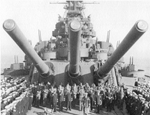 |
147k | Admiral Halsey relieved of Third Fleet command on South Dakota's (BB-57) fantail on 22 November, 1945. | USN photo courtesy of Pieter Bakels. | |
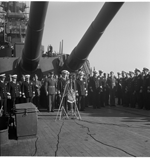 015745w |
1.69k | Admiral William F. Halsey ended his 45-year naval career aboard the South Dakota (BB-57) in the Los Angeles Harbor. He commanded the Third Fleet during the Pacific War against Japan. The ceremony consisted of the changing of his four-starred flag to the two-starred flag of his successor, Rear-Admiral Howard F. Kingman. The ship's entire company was present during the brief ceremony. After the ceremony, Halsey left the battleship on a crash boat and the South Dakota fired a 17-gun salute. | Los Angeles Daily News photo, 22 November 1945, courtesy of digital.library.ucla.edu | |
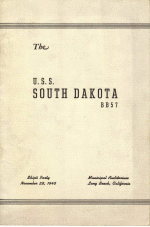 |
2.49k | 11 page PDF article detailing South Dakota's (BB-57) Victory Party Program, 28 November 1945 at the Municipal Auditorium at Long Beach, California. | Courtesy of Robert M. Cieri. | |
 |
296k | A Sikorsky HNS-1, 1945 was the first production helo outside Germany and among the first in the world. Out of 131 built, 22 went to the Navy for training and trial purposes, one of which was used to bring Admiral Halsey aboard South Dakota (BB-57). | Courtesy of Pieter Bakels. | |
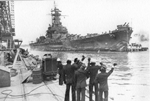 |
194k | South Dakota (BB-57) returns to Philadelphia for mothballing on 20 January 1946. | USN photo courtesy of Pieter Bakels. | |
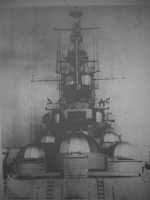 |
280k | South Dakota (BB-57) after mothballing on 20 January 1946. | USN photo courtesy of Pieter Bakels. | |
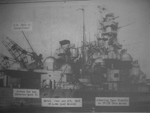 |
280k | South Dakota (BB-57) after mothballing on 20 January 1946. | USN photo courtesy of Pieter Bakels. | |
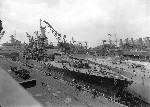 | 667k | Photo taken from Bldg. 620 of Drydock # 5 at Philadelphia Naval Shipyard. The Tennessee (BB-43) in the foreground and the fore section of the California (BB-44) outboard at the Philadelphia Naval Shipyard sometime after 8 May 1946. Note that they are both still flying their ensigns and jacks, so both are still in commission. The South Dakota (BB-57) is in the left background. Across the pier past the California are two 4-stack cruisers of the Omaha class. Stripping is apparently underway on the CLs, with at least one smokestack (on the nearest -- inboard -- ship) removed. Some of the stacks on the outboard ship are hidden behind those of the inboard ship. It appears that the cruisers might be painted in measure MS-21 camouflage, but only two appear to have ended the war in this pattern: Detroit (CL-8) and Trenton (CL-11). Seven of these cruisers were decommissioned and sold for scrap at the Phila. Navy Yard: (1) Omaha (CL-4) scrapped beginning 2/46. (MS-22) dated 1945. (2) Cincinnati (CL-6) scrapping beginning 2/27/46. (MS-22) dated 1945. (3) Raleigh (CL-7) scrapping beginning 2/27/46. (MS32/1D) dated 1944. (4) Detroit scrapping beginning 2/27/46. (MS22 & MS21) dated 1945. (5) Concord (CL-10) scrapping beginning 2/27/47. (MS33/2F) dated 1944. (6) Trenton (CL-11) scrapping beginning 12/29/46. (MS21) dated 1945. (7) Marblehead (CL-12) scrapping beginning 2/27/46.(MS22) dated 1945. It is possible that the outboard cruiser (further from the camera) may not be in measure 21. The stack appears a bit lighter and that would mean cruisers in measure 22 would also have to be included. Note that #4 stack of the outboard cruiser is obscured by #3 of the inboard ship (which also looks a little bit lighter?). In any case both Richmond (CL-9) and Memphis (CL-13) would also have to be considered. This is especially true since Richmond was in MS 21 in late 1945. Also in the background is the former Olympia (ex-C-6) (IX-40). Notice the flatcar going to the storage yards on other side of the lift bridge to Bldg. 750. It is full of single barrel 20mm A.A. mounts is in the foreground on the train/trolley tracks. | USN photo courtesy of Pieter Bakels. Partial text and photo i.d. and a lot of homework courtesy of Mike Green, Aryeh Wetterhorn, Chuck Haberlein, Tracy White & Joe Lewis & Ron Reeves (of blessed memory) (HTC) USNR (ret.) | |
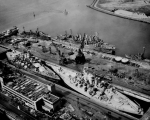 | 102k | Battleships in dry-dock; Tennessee (BB-43) & California (BB-44) taken between 8 May and 27 October 1946. This photo comes from the U.S.Naval Institute and has an accompanying photocopy identifying all of the surrounding ships. It does identify the two cruisers as Detroit (CL-8) (inboard) and Trenton (CL-11)(outboard). It also identifies two returned U.K. DEs: HMS Rupert (DE-96) outboard of Olympia (ex-C-6) (IX-40), and HMS Berry (DE-3) ahead of the cruisers, and visible in the California's photo (it's still wearing its British hull #--K312). The Naval Institute photo was taken at a later date, as more of the "packaging" on the two battleships had been completed. According to Tennessee's deck logs, she entered Drydock #5 with California on 8 May 1946. South Dakota (BB-57) (mid-stern section visible at upper left of photo) subsequently entered Drydock #4--the 1946 "Navy Day" program from the shipyard indicates that this had taken place by 27th October of that year. The four CLs that were scrapped in Drydock #4 at the Philadelphia NSY were: Omaha (CL-4), Cincinnati (CL-6), Raleigh (CL-7) and Marblehead (CL-12). I have two documents from the 4th Naval District, and of course they give different completion dates for the scrapping of these ships. The first document (dated 1 Apr 46) indicates that scrapping was completed on 27 February of that year; the second document (also dated 1 April 46) gives the completion date as 10 March 1946. (My notes also indicate that scrapping was completed at the yard on nine ex-destroyer types as of 29 March 46: Litchfield (DD-336), Pruitt (DD-347), Jouett (DD-396), Clark (DD-361), Balch (DD-363), Sampson(DD-394), Schley (DD-103), Stringham (DD-83) and Whipple (DD-217). The remaining CLs; Detroit (CL-8), Trenton (CL-11), Richmond (CL-9), Concord (CL-10) and Memphis (CL-13) were all sold to the Patapsco Scrap Co. of Baltimore. The sales bid (B-76-47AV T) was opened on 6 December 46; the five ships were sold for $336,140 (or $67,228 each), and custody of the ships was transferred to Patapsco between 27 December 46 and 21 January 47. Note also that the attached photo distinctly shows that both cruisers have all four funnels--I think it's an optical illusion that either of these had had any of them removed. The "light colored objects" in front of the two cruisers might "possibly" be barbettes from the Illinois (BB-65). According to drawings in the 1945 "Gun Mount and Turret Catalog", these two items appear to be about the same diameter as the barbettes for the two BBs' Tennessee & California; 14"/50 triple gun turrets; inside diameter 31 feet, from the same source -- outside diameter would have been about 33 feet. The Illinois barbettes would have an inside diameter about 37 1/4 feet, outside diameter rather over 39 feet. | USN photo submitted by Joe Lewis, courtesy of U.S.Naval Institute. Majority text by Joe Lewis. Chuck Haberlein contributed to the (BB-65) i.d. with text. |
|
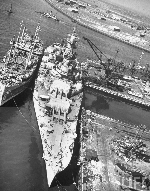 |
216k | The battleship South Dakota (BB-57) resting in the ship storage yard at Philadelphia, PA, 29 August 1946. Note all the secondary weaponry has been removed. |
Photographer: Sam Shere, courtesy of life.time. | |
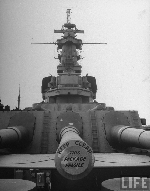 |
106k | The battleship South Dakota (BB-57) resting in the ship storage yard with it's guns sealed, 29 August 1946. | Photographer: Sam Shere, courtesy of life.time. | |
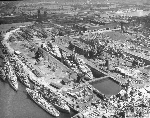 |
216k | The US armed forces ship storage yard at Philadelphia, PA, 29 August 1946. The battleship South Dakota (BB-57) is in the foreground. The Tennessee (BB-43) is to the upper left and the California (BB-44) is to the lower right. Note also the Light Cruisers of the Cleveland Class (CL-55 / 106); possibly Columbia (CL-56), Montpelier(CL-57) or Denver(CL-58) in Drydock # 4. |
Photographer: Sam Shere,courtesy of life.time. Photo i.d. courtesy of Ron Reeves (of blessed memory) (HTC) USNR (ret.) | |
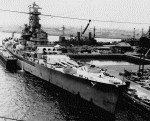 |
167k | Taken at Philadelphia after she entered Drydock #4--the 1946 "Navy Day" program from the shipyard indicates that this had taken place by 27th October of that year. South Dakota (BB-57) after her bow 40mm mounts have been removed. She sailed from the west coast on 8 January 1946 for Philadelphia and a yard overhaul. In June, she was attached to the Atlantic Reserve Fleet. On 31 January 1947, she was placed in reserve, out of commission. |
Photo courtesy of Byron A. Tietjen, FC2C 6/42-12/43. Photo i.d. courtesy of Mike Green & Joe Lewis. Partial text courtesy of DANFS. |
|
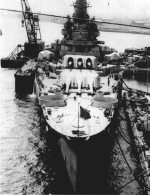 |
131k | Still a commissioned warship as evidenced from the flag flying from her mast at the bow. Bow view of the South Dakota (BB-57) sometime after 8 January 1946 at Philadelphia for a yard overhaul. In June, she was attached to the Atlantic Reserve Fleet. On 31 January 1947, she was placed in reserve, out of commission. South Dakota is athwart DD # 5, as you can see the caisson in the dock is below the sawmill that was on the pier between DD # 4 & 5. That's where the wood for the keel blocks was cut. |
Photo courtesy of Byron A. Tietjen, FC2C 6/42-12/43. Photo i.d. courtesy of Mike Green, Joe Lewis & Ron Reeves (of blessed memory) (HTC) USNR (ret.) Partial text courtesy of DANFS. |
|
 |
128k | South Dakota (BB-57) crew members play music in ship's library, 21 January 1946. (Left to right); Paul Ferla, Joseph Uchman, Frank Salvatore, Geroge Anderson, Austin hallman, Harry Harding. | Photo courtesy of the George D. McDowell Philadelphia Evening Bulletin Photographs @ digital.library.temple.edu. | |
 |
83k | Rear Admiral Ralph S. Riggs (left) and Commander W.K. Parsons shake hands on the deck of the South Dakota (BB-57), 6 December 1946. | Photo courtesy of the George D. McDowell Philadelphia Evening Bulletin Photographs @ digital.library.temple.edu. | |
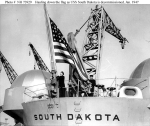 |
121k | Crewmen haul down the National Ensign as the battleship is decommissioned, at the Philadelphia Naval Base, Pennsylvania, 31 January 1947. | Naval History and Heritage Command # NH 73929, now in the collections of the National Archives. | |
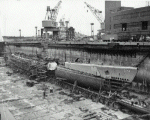 | 94k | Redfin (SSR-272) is in Drydock # 4...Bldg 620 is to the right at the Phila. Naval Yard, 1951, cut in two waiting for the Navigational Information Center to be placed between control and forward battery. The battleship in the background of the photo is the South Dakota (BB-57). It might also be noted from the photo that the South Dakota no longer has the bow mounted 40mm mounts that were carried during the war, having been removed during her 1946 overhaul. | Contributed by John Hummel, USN (Retired). Photo i.d. courtesy of William F. Fessenden & Ron Reeves (of blessed memory). |
|
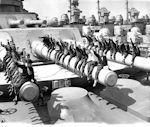 |
279k | Battleship X' attracts young visitors at Naval Base" "During an Armed Forces Day tour of the Philadelphia Naval Base on 22 May 1955, Boy Scouts mount the 16-inch guns on the South Dakota (BB-57). It was the first time in history that visitors were permitted aboard the warship, famed as Battleship X" in World War II. The 35,000-ton vessel is part of the Atlantic Reserve Fleet." |
George D. McDowell Philadelphia Evening Bulletin Photographs @ digital.library.temple.edu courtesy of Mike Green. | |
 |
104k | 24 August 1961 show the South Dakota (BB-57) and cruisers, Dayton (CL-105) and Huntington (CL-107), in the Philadelphia Navy Yard Reserve facility. | USN photo. | |
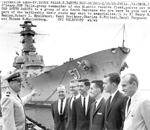 |
1.69k | Cmdr. J. O'Leary, USN Phila group commander of the Atlantic reserve fleet, points out the part of the South Dakota (BB-57) to a group of six South Dakotans who are here to pick out part of the battleship their state may want to memorialize...... 30 June 1962. | UPI Telephoto courtesy of Pieter Bakels. | |
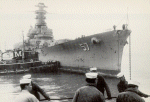 |
84k | 1962 image of South Dakota (BB-57) being removed from Philadelphia to begin her last voyage to the scrap yard. | USNI / USN photo. | |
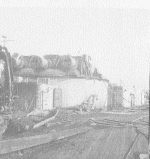 |
64k | Number two turret after the guns were removed. | From Paul Stillwell's book on the South Dakota (BB-57), published by the S. Dakota Memorial Foundation. | |
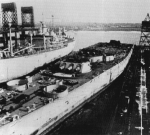 |
116k | Late 1962 - early 1963 photo of the South Dakota (BB-57) being scrapped. | USN photo. | |
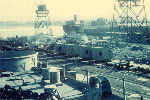 |
220k | Onboard of South Dakota (BB-57), taken at Kearny, NJ., while being scrapped. Note the 5'' turrets on the side. | USN photo courtesy of Pieter Bakels. | |
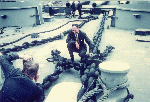 |
113k | Taken aboard South Dakota (BB-57) at Kearny, N.Y., while being scrapped. | USN photo courtesy of Pieter Bakels. | |
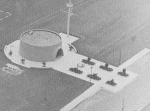 |
173k | South Dakota Memorial Foundation Museum. | From Paul Stillwell's book on the South Dakota (BB-57), published by the S. Dakota Memorial Foundation. | |
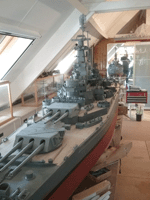 015747v | 1.47k | 1/48 scale model of the South Dakota (BB-57) built by Pieter Bakels. | Photo courtesy of Pieter Bakels. | |
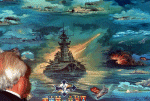 | 376k | A guest studies a painting depicting the history of battleships. The artwork was painted by George Skybeck and presented to the Pearl Harbor Survivors Association during their annual banquet at Honolulu, Hawaii, on 8 December 1991. | USN photo # DN-SC-92-05391, by PHC Carolyn Harris, from the Department of Defense Still Media Collection, courtesy of dodmedia.osd.mil. | |
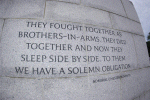 | 371k | A quote made by Fleet Adm. Chester W. Nimitz is inscribed on a granite wall at the National World War II Memorial located on the National Mall in Washington, D.C. Fleet Adm. Nimitz was the United States signatory to the surrender terms aboard the battleship Missouri (BB-63) in Tokyo Bay, Japan on 2 September 1945, thus ending World War II. Established by the American Battle Monuments Commission, the memorial honors all military veterans of World War II, the citizens on the home front, the nation at large, and the high moral purpose and idealism that motivated the nation's call to arms. On 29 May 2004, the memorial was formally dedicated with an estimated 200,000 people expected to attend, and includes 100,000 visiting veterans of all wars. | USN photo # N-0295M-011 by Photographer's Mate 2nd Class Daniel J. McLain, courtesy of news.navy.mil. | |
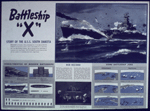 |
2.54k | South Dakota (BB-57) as Battleship X. | Photo courtesy of wikimedia & NARA_-_513922. | |
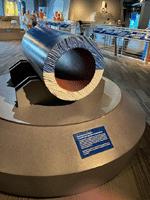 015708c |
515k | Part of a 16 inch gun from South Dakota on loan to the Wisconsin museum. | Photo courtey of Austin Oliver. | |
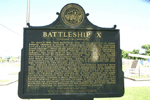 |
1.03k | 17 photo PDF of the South Dakota (BB-57) at Sioux Falls, S.D. | Photos courtesy of Robert Hall. | |
| Commanding Officers | ||
| 01 | CAPT. Gatch, Thomas Leigh, USN (USNA 1912) :VADM | 20.03.1942 - 15.11.1942 |
| 02 | CDR. Uehlinger, Archibald Emil, USN (USNA 1922) :RADM | 15.11.1942 - 31.01.1943 |
| 03 | CAPT. McCormick, Lynde Dupuy, USN (USNA 1915) :ADM | 31.01.1943 - 00.00.1943 |
| 04 | CAPT. Smith, Allan Edward, USN (USNA 1915) :VADM | 00.00.1943 - 17.03.1944 |
| 05 | CAPT. Riggs, Ralph Smith, USN (USNA 1918) :VADM | 17.03.1944 - 30.11.1944 |
| 06 | CDR. Stillman, Carl Frederick, USN (USNA 1927) | 30.11.1944 - 09.12.1944 |
| 07 | CAPT. Momsen, Charles Bowers (Swede), USN (USNA 1920) :VADM | 09.12.1944 - 30.07.1945 |
| 08 | CDR. Stillman, Carl Frederick, USN (USNA 1927) | 30.07.1945 - 17.08.1945 |
| 09 | CAPT. Forrestel, Emmet Peter, USN (USNA 1920) :VADM | 17.08.1945 - 01.12.1945 |
| 10 | CAPT. Todd, Carlton Rice, :RADM | 01.12.1945 - 20.06.1946 |
| 11 | CDR. Parsons, William King, | 20.06.1946 - 21.12.1946 |
| 12 | CDR. Schmidling, Matthew Stelzner, USN (USNA 1931) | 21.12.1946 - 31.01.1947 |
The contact listed, Was the contact at the time for this ship when located. If another person now is the contact, E-mail me and I will update this entry. These contacts are compiled from various sources over a long period of time and may or may not be correct. Every effort has been made to list the newest contact if more than one contact was found.
| Back To The Main Photo Index | Back To The Battleship Photo Index Page |